- BOAT OF THE YEAR
- Newsletters
- Sailboat Reviews
- Boating Safety
- Sails and Rigging
- Maintenance
- Sailing Totem
- Sailor & Galley
- Living Aboard
- Destinations
- Gear & Electronics
- Charter Resources
- Ultimate Boat Giveaway


2022 Boat of the Year: Best Performance Catamaran
- By Cruising World Editors
- December 15, 2021
During and in the four days immediately following the US Sailboat show in Annapolis, Maryland, the Cruising World judges inspected and sailed on 27 boats vying for recognition. Learn more about the boats in our 2022 Boat of the Year »
OK, confession time. When the roster of nominees for the 2022 Boat of the Year awards was released, the contest’s team and judging panel couldn’t help themselves, and quietly put three check marks, little symbols of anticipation, alongside a trio of boats: the untamed cats that would vie for the title of best performer in their class. After all, both Balance and Seawind had entered the winner’s circle in previous BOTY competitions, and it was clear they’d have a serious contender for the throne in yet another player from cat-crazy South Africa, the Kinetic KC54. How’d it go? Let’s just say, nobody was disappointed. The conditions on Chesapeake Bay were ideal for putting the three nominees through their paces, and the trio of scalded cats all acquitted themselves superbly.
For 2022, if anything, the trend for flybridge catamarans is on a major upswing. New cats for 2022 from both Lagoon and Fountaine Pajot continued down that design path, putting an emphasis on living accommodations, not performance. But not aboard the latest Seawind 1600 , a brand originally built in Australia that is now produced in Vietnam. And that suits judge Tim Murphy just fine. “This boat was very dialed in,” he said, “and one place Seawind has always been innovative is with their helms. This one was really great; it was -outboard and aft with great visibility, sort of half-protected where you could step in and out. There was also good access to the boom and mainsail, which you don’t always see on cats. The deck layout was excellent, particularly the forward trampolines. Some cats have lacings with large openings where you can twist an ankle, but these were nice and tight.”
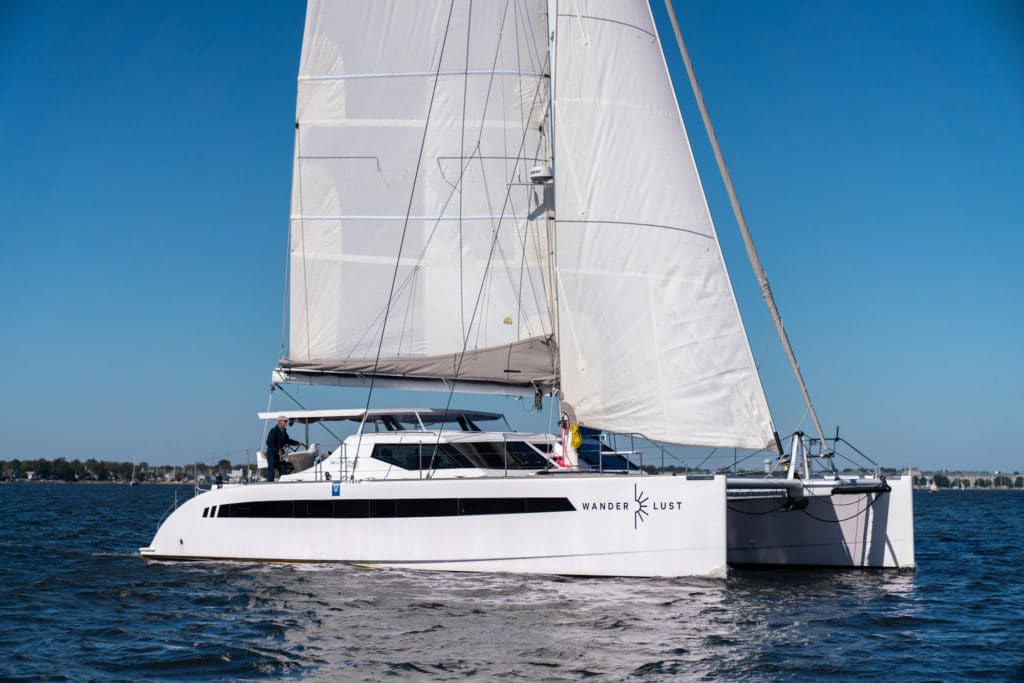
“Compared to other Seawinds that I’ve seen, I was just blown away with it in terms of what it could do and how it performed,” said Ed Sherman. “It’s a fairly conservative boat in terms of technology compared to some of the other boats in the same category, which depending on a potential buyer’s state of mind, could be either a good thing or a bad one. I loved the centralized winch aft which is where all the sail-handling takes place. It’s pretty brilliant for a short-handed crew, and it’s all in a very safe and easy-to-access location that a cruising couple can deal with without scaring the heck out of themselves.”
The Kinetic KC54 is a fresh entry in the cat universe, and we’ll let Tim Murphy get right to the point: “This is a fairly new company that was started within the past couple of years. My breath was absolutely taken away by this boat; it was spectacular. I think it was the best-built boat in the entire fleet. It’s an all-carbon boat, with a foam core, epoxy resin, all infused–fantastic. The whole boat felt integrated. You didn’t feel like there was a conflict between the forces in terms of accommodation versus performance.” With a price tag approaching $3 million, it perhaps should not be astonishing. That was a major factor in evaluating the boat, and while it did not win its class, the experts panel did present it with a Judges’ Special Recognition prize to honor the boat’s overall excellence.
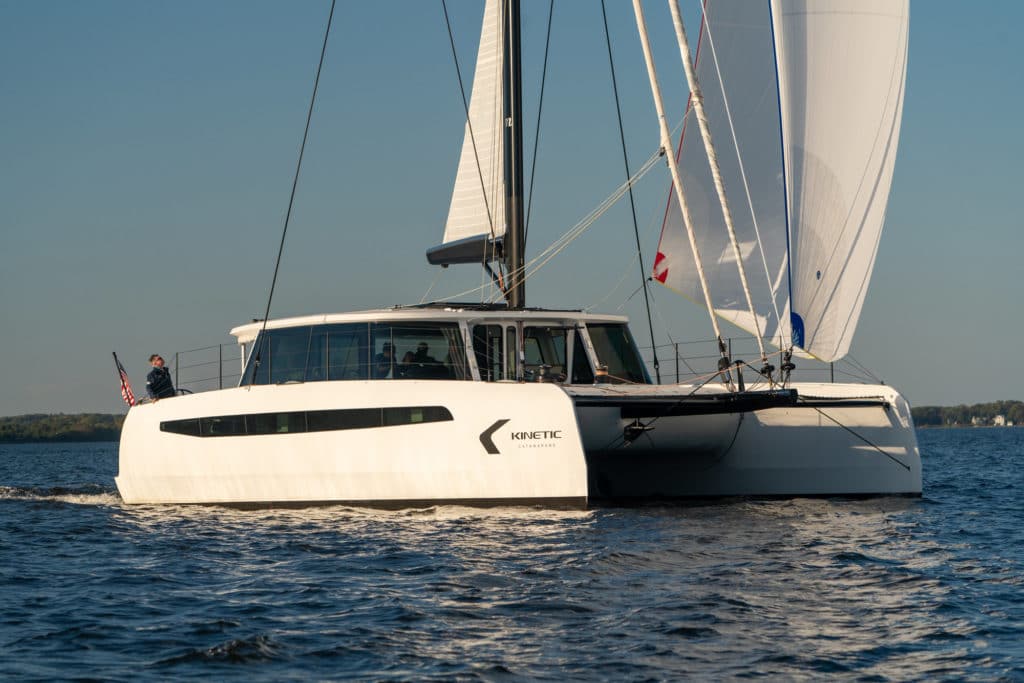
“It was my personal favorite in this year’s contest,” said Sherman. The materials that were used are absolutely the highest quality available in our industry at this point, and it’s a very high-tech boat in terms of systems.” Gerry Douglas was also duly impressed: “This was the Tesla of sailboats. I think that that was their model. In terms of design and execution and technology, it hit all three of those marks. This boat is built without compromise, and what it cost was not an issue, they just wanted to do the best they could in every aspect of the boat. The construction was impeccable, the fit and finish was amazing. There are some very clever design things in the boat, but it all really worked seamlessly.”
With that level of competition, the Balance 482 had a tall order to overcome to win its class. And it did. “The sailing performance was excellent,” said Douglas. “The boat felt really good. The steering was terrific. The structure of the boat throughout was exemplary. Storage is really good. Visibility was good. Ventilation was great. There was even a rain collection system on the cabin top, which is the only one of the boats we looked at had that. It was very well concealed because the gutters formed a handhold going forward. The solar panel installation was also well done. The panels were encapsulated into a fiberglass tray that elevated the deck so the panels wouldn’t overheat. Very clever.”
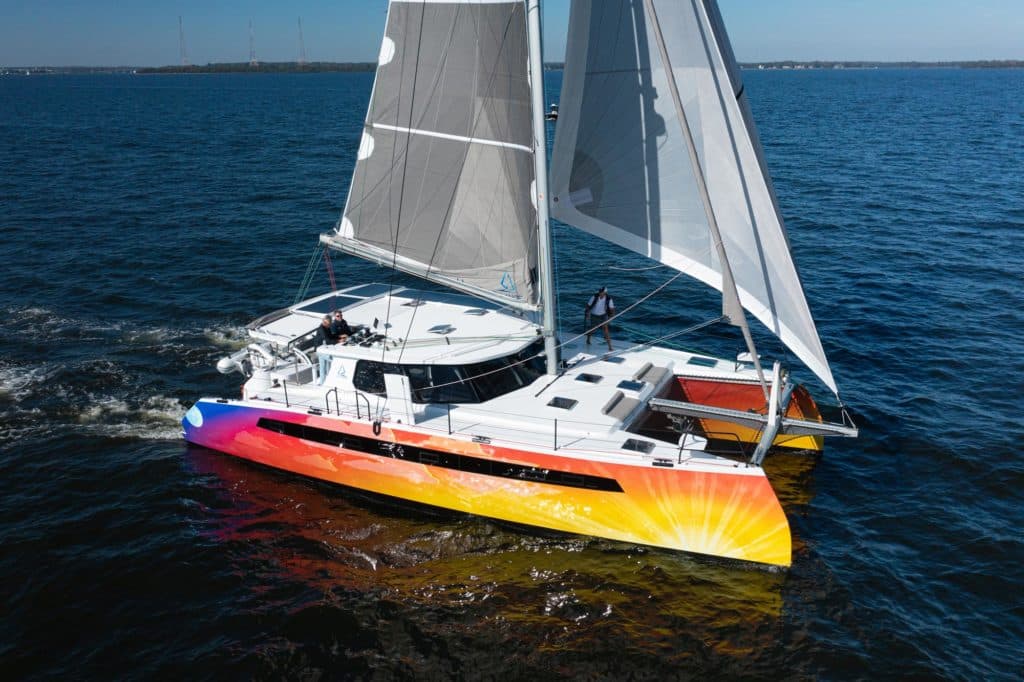
The driving force behind Balance cats is Phil Berman, a world champ at racing beach cats who brought that passion to developing and marketing fully found cruisers. Judge Murphy knows him well: “Phil comes from a very strong view of wanting to see boats that have solid sailing performance. He’s also a strong proponent of daggerboard boats, which tends to be quick shorthand for the dividing line between cats that are more about payload versus cats that are about performance, but not so much where you’re going to fly a hull or break a rudder. There’s a balance within a boat that really performs that you can still live aboard.” A winning balance, it turns out, with the Balance 482 securing its position as the Best Performance Cruiser for 2022.
- More: balance catamarans , Boat of the Year , Boat of the Year 2022 , catamaran , Kinetic Catamarans , print 2022 jan , Sailboats , seawind catamarans
- More Sailboats

Sailboat Preview: Elan GT6 Explorer

For Sale: 1984 Camper & Nicholsons 58

Alubat Updates OVNI Models

For Sale: Little Harbor 63 Ketch
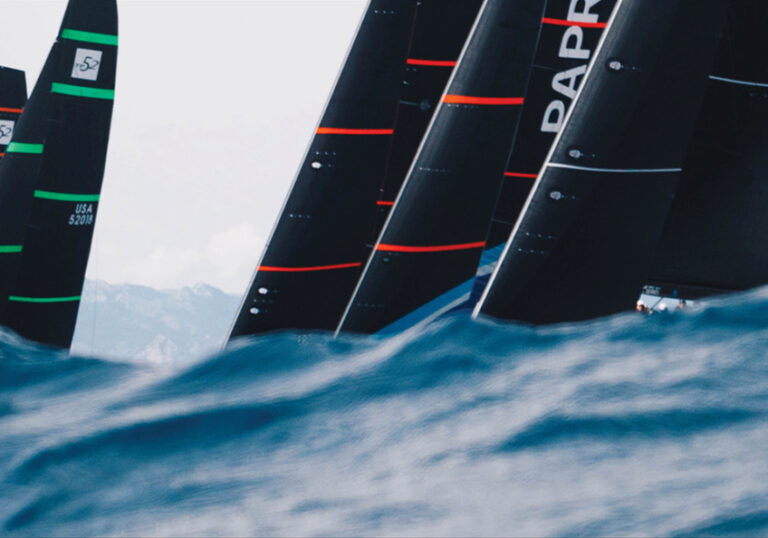
North Sails Parent Company Buys Doyle, Quantum
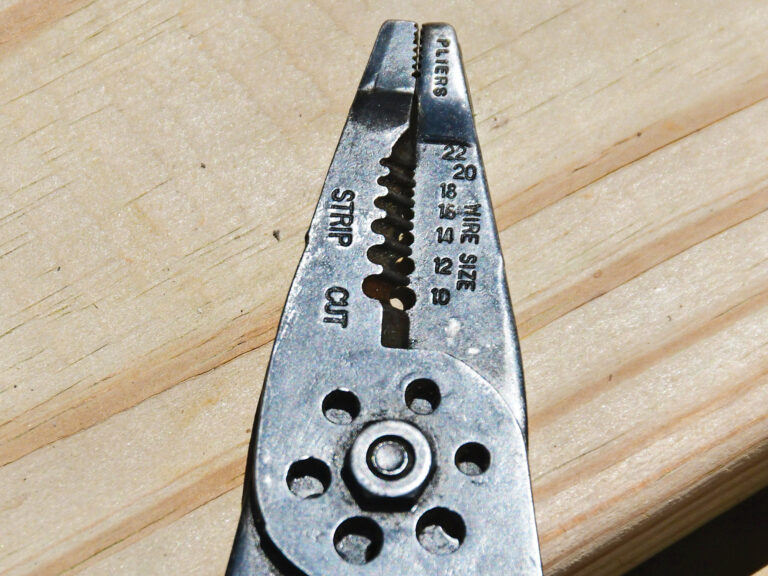
Top Tools for Sailboat Cruising: Must-Have Gear for 2024
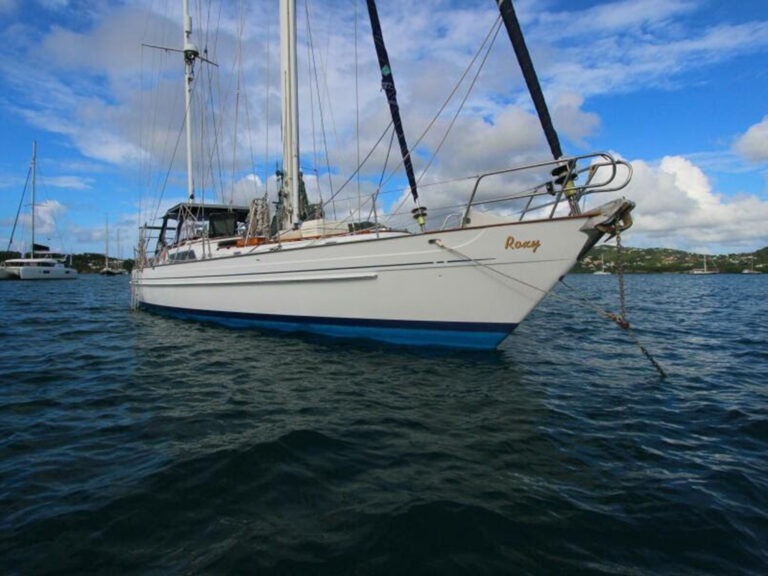
Sailing Avocet : A New Adventure Begins
- Digital Edition
- Customer Service
- Privacy Policy
- Terms of Use
- Email Newsletters
- Cruising World
- Sailing World
- Salt Water Sportsman
- Sport Fishing
- Wakeboarding

My Cruiser Life Magazine
Fastest Catamarans for Cruising in 2023
Catamarans appeal to sailors and would-be sailors for a variety of reasons. One of those reasons is the need for speed—cats have a reputation for being faster. There are dozens of brands and tons of great boat designs that capitalize on this, and designers are constantly pushing the bounds and asking, “Really, how fast can a catamaran go?”
Performance sailing catamarans may look like your run-of-the-mill Leopard or Lagoon from a distance. But these boats are full of little tricks to boost their speeds—narrow hull designs, retractable daggerboards instead of keels, and extensive use of cutting-edge lightweight materials like carbon fiber. All of this adds up, so expect to pay double, triple, or maybe much more for a truly fast catamaran. And that means there are far fewer boats on the water, and owning one puts you in an exclusive club.
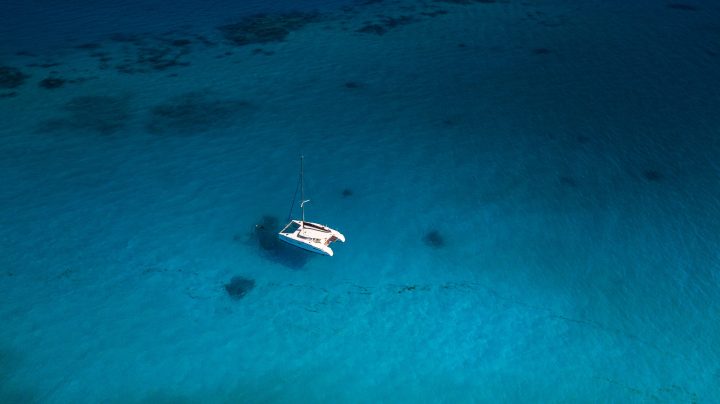
Table of Contents
Neel trimarans, what is a fast catamaran, how fast can a catamaran go, are fast catamarans the boat you’re looking for, fast catamarans faqs, top brands of fast catamarans.
Here’s a list of some of the best-known and trail-blazing fast catamaran makers. These companies are making luxury performance catamarans suited for owners who want to cruise fast. These aren’t barebones race boats built for nothing but speed. Instead, these are comfortable boats that will outperform most others in their class.
Most performance boats will be 45 feet long or more. Small catamarans don’t fall into this category, and most production liveaboard catamarans are built too heavily in order to save money.
For more than two decades, Gunboat has been setting the bar on what a performance catamaran can be. They took state-of-the-art technologies from the racing world and applied them to family-friendly cruising catamarans. The company started in the US in 2002. One of the company’s stated missions is to create boats that sail faster than the wind in anything more than 6 knots of breeze.
Since 2016, Gunboat has built top-quality boats at their La Grande-Motte, France, facility. However, they are still a boutique builder making only a handful of boats yearly. Their current offerings include the 68, 72, and 80. All boats have narrow hulls, retractable boards, high-performance sail plans, carbon fiber construction, and luxurious living accommodations.
The first hull of the Gunboat 68, CONDOR, was launched in 2019 and set out on a trans-Atlantic crossing immediately after its sea trials. The crew wrote a detailed report of the experience and the boat’s performance. CONDOR exceeded 30 knots occasionally, but average speeds were between 14 and 17 knots. Their best 24 hours saw 328 nm (an average speed of 13.7 knots).
The company motto says it all. “Life is too short to sail a slow boat.”
Outremer Catamarans is one of the original makers of French performance cats, in business since 1984. According to their website, the company has made over 300 boats since then. A large-scale production boat maker they are not. These are custom-built fast catamarans of the highest quality, made for safety, comfort, and speed. Outremer recently received much attention when popular YouTubers Sailing La Vagabonde sailed aboard an Outremer 45 for several years.
Currently, Outremer offers boats ranging from the 45 to the 5X (48 to 60 feet long). The X models (4X and 5X) are even more performance-oriented, with more extensive use of carbon fiber and a more race-inspired sail plan.
View this post on Instagram A post shared by Riley Whitelum (@riley.whitelum)
Catana is yet another French performance brand of luxury cruising catamaran. Today, Catana Group also makes Bali cruising catamarans, effectively marketing Catanas to the performance set and Bali’s to the cruising and charter set. https://www.catana.com
Presently, Catana is only making two models, the OC50 and the 53. Historically, however, Catana has made many beautiful boats. Notably, the 471 is a fast cruising catamaran that is a favorite among long-distance cruisers. On the smaller side, the 431 and even the 401 and 381 are quick and fun sailers that move better than their competition.
Catanas are easily recognizable by their daggerboards and narrow hulls with asymmetrical designs. In addition, they use a lightweight composite layup that results in a very stiff boat that weighs less than their competitors. Still, Catanas are not on the same level as an Outremer 5X or Gunboat–these are fiberglass boats that are built better than the competition and made to outperform many other boats.
HH Catamarans is Gunboat’s first real competitor in the high-end performance cat market. They started in 2012 and are part of the Hudson Yacht Group. The boats are designed by Morrelli & Melvin, a highly-regarded multihull design firm, and are built in Xiamen, China, or Cebu, Philippines.
HH has boats in their model line from 44 to 88 feet long. The company focuses on providing what owners and sailors want and are looking for, so you’ll see lots of customizability within the lineup. They include features you won’t find from a lot of builders, including lots of planned real estate for solar panels (5kW or more!), hybrid drive systems, and ocean cruising OC (keels) or sport cruising SC (daggerboard) models to pick from.
View this post on Instagram A post shared by HH Catamarans (@hh.catamarans)
Balance started in South Africa in 2013. They focus on making semi-custom, comfortable performance yachts that are strong and safe and can be easily operated single-handedly or by a couple. They are live-aboard boats that strike a balance between comfort and performance. But, compared to the current offerings from Lagoon or Leopard, it’s clear that Balance cats skew far more toward performance than others do.
Models currently range from the 442 to the 750. They’re available with daggerboards or keels and made with extensive carbon fiber and all epoxy-resin composites. According to their website, the current record speed for a Balance 482 while surfing is 28 knots. She’ll cruise all day between 8 and 14 on a reach, though. They describe the 482 as a “trend-setting circumnavigator”—the perfect boat for your sail around the world route .
Kinetic Catamarans are designed by Simonis Voogd and built in Knysna, South Africa. Like others on the list, these are semi-custom, luxury, performance cruising cats with an emphasis on speed. They have all-carbon construction, carbon spars, laminated sails, and a forward sailing cockpit deck layout.
Since they are truly semi-custom, each boat is spec-ed out to each buyer’s vision. This includes standard or racing rigs, centerboards or daggerboards, and many furnishings, layouts, and outfitting options. Kinetic currently offers 54 and 62-foot versions.
What’s better than two hulls? Three, maybe. That is, three might be better if your goal is truly fast sailing. Neel Trimarans is a new French builder attempting to capitalize on this simple fact by merging the best of all worlds—the space and liveability of a cruising catamaran with the performance, sail efficiency, and stability of an offshore-capable tri.
The company presently offers models between 43 and 65 feet. They say cruising speeds are reliably over 10 knots, with 15 to 18 knots when the breeze freshens. Compared to cats, these boats’ rigid central hulls allow for stronger rigging and better upwind performance, and the central keel allows better tracking and rudder control.
Now you’ve looked at some fast cats, you might wonder what constitutes “fast.”
You will be wowed if you’re selling your 30-foot monohull and moving up to a 50-foot cat. But if you’re coming from the world of car and plane travel, sailboats of any ilk are anything but “fast.”
The first thing to accept is that all sailboats are slow . This shocks many people who think they’d like to travel and see the world by sailboat. The marketing of these “fast cats” is everywhere, and the idea that the faster boat is safer because you can “beat the weather” is especially pervasive. No sailboat at sea can outrun a front or storm cell moving at 30 or 40 knots.
In truth, the fastest catamaran you can comfortably live aboard and cruise on will average out under 15 knots . In similar conditions, production catamarans might be doing 10 to 12. The monohull speeds of the same length might be 7 or 8 knots, and a bigger monohull with similar living space might be doing 10 or 12.
So don’t be lulled or wowed by these vessel’s maximum speed or “surfing” claims—they’re fun numbers to kick around with your dock neighbors, but what really matters is how many miles you can tick off in a day of travel.
To get more speed than this, you’ll either push the boat in ways that are not safe or comfortable at sea, or you will have to find bigger, more advanced, and even more expensive vessels. Most boats on this list are luxury liveaboard that is safe to travel the world.
But are they fast? As the old sailor saying goes, “Nothing goes to weather like a 747.” Sailing is still sailing. And sailing is a slow, slow, slow way to see the world.
Traditional monohull sailboats are displacement vessels that are limited by a few rules. As they push the water out of their way, they build up bow and stern waves. Push too much water, and the waves get bigger, pulling the vessel farther into the water. So no matter how you power it, it’s limited to hull speed. Hull speed is a factor of waterline length, width of the hull, and displacement.
Modern designs favor flat bottoms like powerboats, with the idea that they can surf and plane to get more speed. Catamarans take this even further, and with some clever design tricks , it’s possible to get a catamaran well above displacement speeds for extended runs. Of course, a lot depends on the hull type, and other factors are also at play.
Catamarans are very sensitive to weight . Their speed comes from being a lightweight boat with the ability to fly across the water, contrary to how a heavy monohull plows through it. The heavier the boat, the lower it sits in the water.
Therefore, adding weight to any catamaran will slow it down. To this end, finding a performance-oriented liveaboard catamaran less than 47 feet long is difficult. Less than this, and the narrow hulls simply can’t hold the weight of you and your stuff.
Finally, there’s the consideration of the environment you’re sailing in. The wind is obvious—they sail fastest on a broad reach. And, just like any other type of boat, they are slowest when close-hauled and on a run.
Rough seas are another of the catamaran characteristics to consider in your need for speed. Often the boat is capable of more, but the ride is rough and uncomfortable.
So you shorten sail and slow down to find the sweet spot of comfortable sailing speed—enough power to maintain a good speed without pounding your brains out and causing undo fatigue on the crew. And, of course, the rougher the conditions, the slower the boat’s performance as she slows and in the troughs and speeds “downhill.”
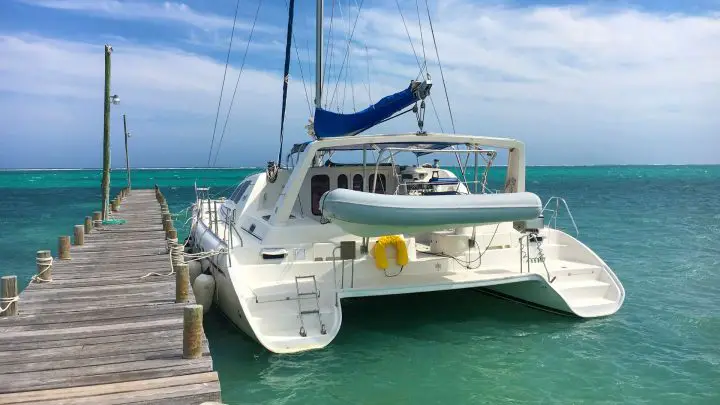
While they are faster than other vessels, that’s certainly not the only thing catamarans have going for them. Fast is a relative term, and “fast” sailing is still awfully slow. So unless you already love sailing, sailing fast might not have as much appeal as you’d expect.
Catamarans are great vessels with a lot of pluses. And these fast modern catamarans are some of the best—luxurious living space aboard comfortable, top-quality vessels.
What are the fastest catamarans?
Like those used in recent America’s Cup races, pure racing catamarans use foils to lift their hulls out of the water. Whether performance-oriented or not, regular catamarans for cruising are much slower, averaging between 10 and 15 knots. Still, they generally outperform monohull sailboats of similar lengths in most conditions, especially when sailing downwind.
How fast does a 50 foot catamaran sail?
There are many designs of catamarans, and they all sail differently. In some conditions, a pure racing catamaran may sail significantly faster than the wind speed. Most cruising catamarans, whether designated as “performance” or not, will max out around 12 to 15 knots. Momentary peak speeds may be significantly higher.
What is the fastest point of sail catamaran?
As with all sailboats, the fastest point of sail will be near a beam reach, where the apparent wind is 90 degrees from the boat’s bow. Since cats travel faster over the water, this usually means that the true wind is off the quarter, with a true wind angle of about 120 degrees off the bow.
How fast is the Gunboat 68?
Gunboat 68, hull number 1 (68-01), was launched in 2019. Immediately after sea trials, CONDOR crossed the Atlantic . The crew reported the vessel’s max speed exceeded 30 knots occasionally, with averages between 14 and 17 knots. Their best day was 328 nm, making the average speed for those 24 hours 13.7 knots (15.8 mph).
Matt has been boating around Florida for over 25 years in everything from small powerboats to large cruising catamarans. He currently lives aboard a 38-foot Cabo Rico sailboat with his wife Lucy and adventure dog Chelsea. Together, they cruise between winters in The Bahamas and summers in the Chesapeake Bay.
Leave a comment
Your email address will not be published. Required fields are marked *
Save my name, email, and website in this browser for the next time I comment.
Go-Fast Boats: Beginner's Guide to the World of Speed
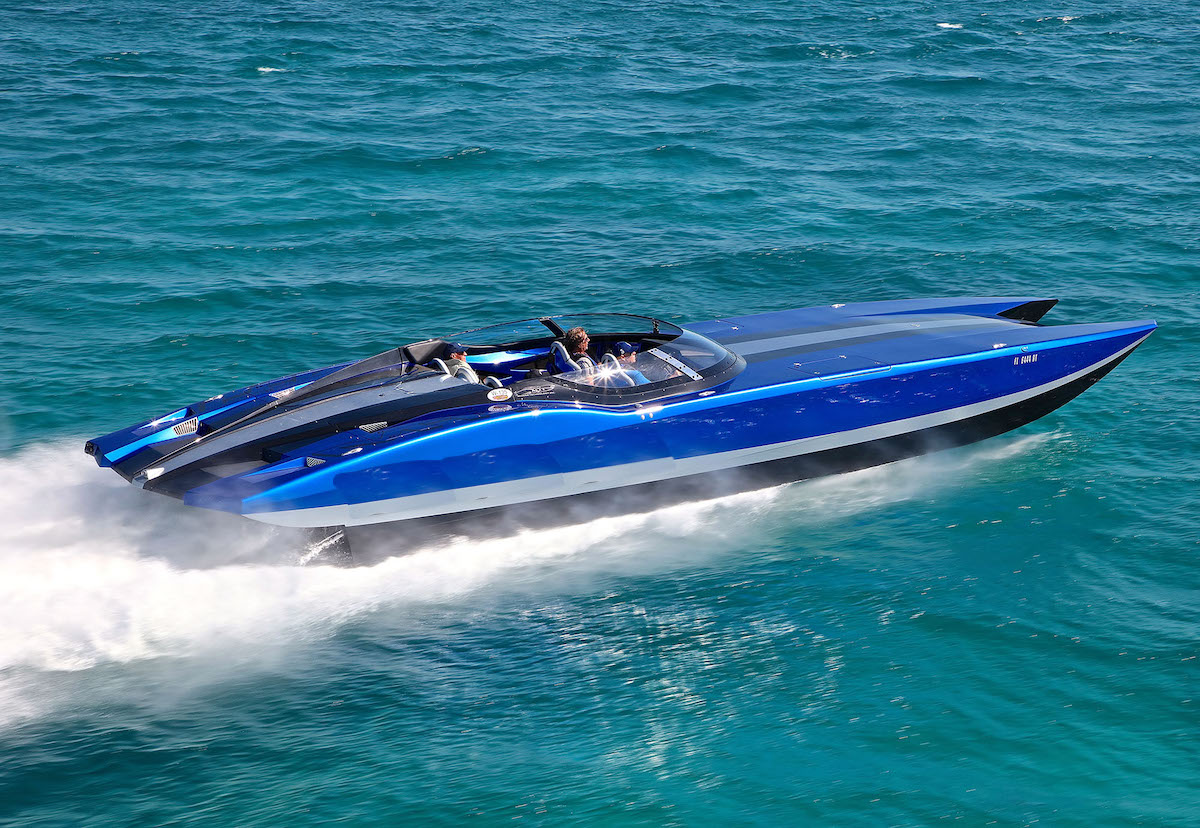
Speed on the water is a rush like no other, and if by chance it captures your imagination you’ll likely spend the rest of your powerboating days chasing it. Not everyone who enters the boating world discovers his or her inner speed gene. But for those who do, it quickly becomes a passion—and likely a lifelong one.
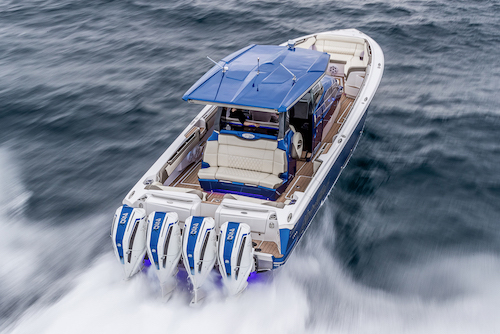
But assuming you end up on the “love” side of the equation, there are more than a few things that you, as a novice getting into go-fast boating, need to know. What follows is a quick, though by no means comprehensive, question-and-answer guide. It won’t provide everything you need to know, for the education of a powerboat owner, especially in the high-performance realm, never stops. But it will help you understand some of the basics.
Learn More about High Performance Boats
Different Types of Go-Fast Boats
Go-fast boats essentially break into two hull categories:
- V-bottom (mono hull)
- Catamaran (twin smaller “sponson” hulls with a “tunnel” between them)
Picture “one of those Cigarette boats” and you have a classic V-bottom. Though most are powered by inboard stern-drive engines, a few are offered with outboard-engine power. Their lengths range from 20 to more than 50 feet. Most often, they have single or dual engines. They range from bare bones, meaning a steering wheel, a throttle and two gauges (speedometer and tachometer), to plush with multiple GPS units, front and rear video cameras, FLIR systems, monster stereos, plus cabins and more.
Sticking with the Cigarette mental image, a traditional V-bottom sportboat has a closed deck and a cockpit behind it. Today’s fastest V-bottom sportboats top out at more than 150 MPH.
Center Consoles
More popular these days, however, are V-bottom-based “center consoles” with open-cockpit layouts with bolster seats and lounges from bow to stern and tiny-to-generous cabins inside the consoles. Most high-performance center-consoles are powered by two to four outboards. Top speeds range from 60 to 85 MPH.
Go-Fast Catamarans
Today’s most popular go-fast catamarans range from 28 to 52 feet. Powered by twin inboard engines up to 1,750-HP, they can reach 180 MPH and beyond. Once again, it goes without saying—but still needs to be said—that boats in this rather extreme category take years of experience to learn to handle safely.
A sport catamaran, meaning outboard-engine-powered cats from 28 to 38 feet long, are the hottest things in the go-fast boat segment these days. Equipped with twin outboard racing-style engines, the fastest top out at 130 MPH. Thanks to the outstanding reliability built into today’s outboards and overall ease of use as compared to their larger, higher-maintenance stern-drive counterparts, sport cat popularity has exploded in the last five years.
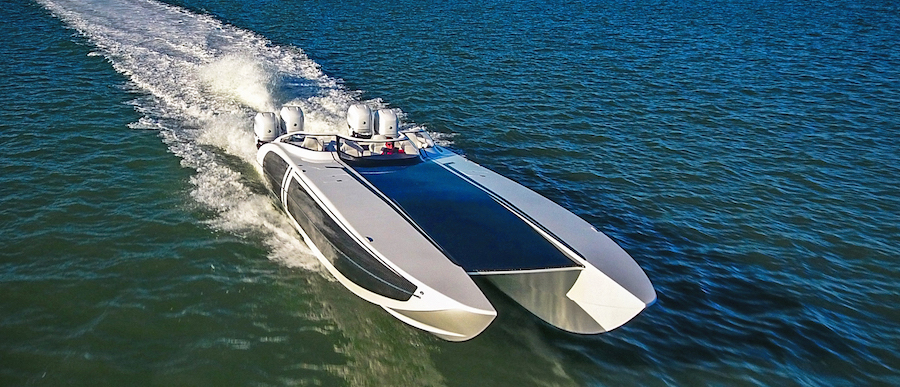
How Much Does a Go-Fast Boat Cost?
If you’re looking at an entry level new go-fast powerboat, you can expect to spend no less than $100,000. That might seem like a lot of money and, in fact, it is, but it’s not out of line with the pricing in rest of the powerboat world (more than a few ski/wake tow boats list for 50 percent more than that).
Of course, you spend far less than $100,000 in the pre-owned go-fast boat market. On the flip side, you can spend more than $1 million on a new custom creation.
Other Related Costs
Being new to go-fast boating and excited about the world you’re about to enter, this you forget to ask this question. But it’s an important one, so we’re asking it for you.
Short answer: Yes.
Longer answer: Like all forms of powerboating, the high-performance segments includes costs beyond the boat, the most obvious one being fuel. High-horsepower marine engines demand fuel, often higher octane and hence more-expensive fuel, to make power. And they tend to burn a lot of it. By automotive standards, five miles per gallon is appalling. But powerboating—all powerboating—it’s world-beating, even for outboard engines.
Other costs include insurance, which is higher for go-fast boats than it is for boats in other segments. The faster the boat, the more expensive and expensive and difficult it is to insure. Though high-performance marine engines, especially Mercury Racing’s inboard and outboard offerings, have become far more reliable than they once were, they still require more routine maintenance than the lower output engines found in general-use powerboats.
Costs of Boat Ownership Guide
Go-Fast Boats: Frequently Asked Questions
How fast can high-performance boats go?
To make things simple, we’ll define any powerboat that exceeds 70 MPH as a high-performance boat. These days, there are plenty of boats that can run more than 120 MPH and several models that—with enough horsepower—can top 180 MPH. It should go without saying, but still needs to be said, that the highest tier of performance boats take years of experience and a careful, methodical progression to learn to handle safely.
How do I get involved in high-performance boating?
If your family owned a powerboat, there’s a good chance that you might end up owning one someday. Lifelong boat owners typically were exposed to the activity as children. To the outsider, the whole “powerboating thing” can seem intimidating, whereas those who grow up around boats have a hard-coded comfort level with all that boating entails.
Your best bet if you think a go-fast boat appeals to you? Get a ride in one. There are more than a few dealers around the country who can make that happen for you. If you like it, you’ll move forward. If not, move on.
Assuming you like it, you’ll need to take more rides—and we mean a lot of them—with dealers and builders. Don’t be afraid to ask hard questions and don’t be afraid to go elsewhere if the folks introducing you to the go-fast boating world can’t answer them.
How do I learn to drive (and safely handle) a go-fast boat?
Volumes could be written about the progression of go-fast powerboat ownership, but the most simple and solid path is to start small and work your way up.
- For a novice , trying to dock a 50-foot, twin-engine V-bottom in a crosswind, much less run it at speed, would be a horrific and potentially dangerous experience.
- For a seasoned go-fast boat owner , it’s routine—but routine that always needs to be approach with respect and caution. More than a few owners of big, multi-engine catamarans started with a 20-foot V-bottom. And it took them years, as it will take you, to progress up the ladder.
So be patient. Your life and the life of every passenger in your boat depends on it. And get instruction , whether it be from the manufacturer such as MTI or Nor-Tech or an outfit like the Tres Martin Performance Driving School. Listen, learn, ask lots of questions—there are no dumb ones—and take it slowly.
Nothing is without risk. Your job, through a slow progression to experience and competent instruction, is to do your best to minimize it. In time, you’ll be going plenty fast. That’s just what happens when the aquatic speed bug bites.
Explore Go-Fast Boat Brands
You Might Also Like:
- High Speed Holiday
- Boat Buyer's Guide: How to Buy a Boat
- First Time Boat Owners: How to Get Started
- Docking a Boat: Step-by-Step Guide
- Find the Right Boat for Your Lifestyle

Join Our Newsletter!
Get community news, buying bargains, and how-to guides at your fingertips.

Berthon Winter Collection

Latest issue

August 2024
In the August 2024 issue of Yachting World magazine: News Few finish a tempestuous Round The Island Race European rules are eased for cruising to France and Greece Olympic sailing…

Yachting World
- Digital Edition

Performance cruisers: the best new catamarans for racing and fast cruising 2018
- Toby Hodges
- August 20, 2018

This is where the worlds of racing and cruising multis meet, where we see high-tech lightweight craft that use exotic materials and daggerboards to help produce electrifying sailing. Gunboat was arguably the first to identify this market on a luxury level, and has since been joined by HH, McConaghy, Ice Cat, and ITA.
And then there are the performance multis that are more minimalist and lean more towards the offshore racer than cruiser – like Marsaudon, Dragonfly, Banuls, Dazcat, and Rapido… fun factor guaranteed!
Just launched: McConaghy MC50

Fresh from the Australian composite wizards McConaghy, the MC50 is the smallest series catamaran in a new range that runs up to 90ft. Drawn by Jason Ker, renowned for his IRC winners, the MC50 has performance in her DNA, designed as a fast cruising cat, capable of crossing oceans. The MC line has incorporated input of experienced owners and sailors, and includes some impressive features. For example, the doors between the saloon and the cockpit concertina, while the saloon windows slide open electrically for al-fresco living. A skylight down the middle of the coachroof lets light flood in, and can be specced as a large ‘solar glass’ generator to keep batteries topped up. Then there is the standard cross brace between the bows, which has been eliminated by using a carbon fibre longeron down the boat’s centreline, tensioned with Nitronic rod stays. The first hull launched in time for La Grande Motte boatshow in April and the performance predictions are bold. Polars from McConaghy suggest speeds of over 10 knots in a stiff Force 6, at 30° off the true wind. Bear away onto a broad reach and she is expected to manage 21 knots-plus. Upwind performance is boosted by 3.5m-deep hydraulic daggerboards in each hull, which include a fail-safe in the event of underwater collision. “We expect her to track upwind extremely well,” says James Kinloch of McConaghy. And yet this is no pared-down raceboat. The saloon has deep seating to starboard and an extending table gives dining space for at least eight, and can convert into lounging room if you drop the table and install the fill-in cushion. The galley and island unit to port are more penthouse than deckhouse, with induction hob and moulded-in sinks. Sensibly, there is a navigation station at the forward end of the saloon, with good visibility ahead and access to all the systems. The styling was undertaken by Design Unlimited. “The concept was to create a penthouse apartment on the living deck,” says Ole John, director of McConaghy Multihulls Europe. “The 35-40m2 of space must be the biggest for a 50ft yacht.”

First impressions

The MC50 is a clever boat. A Ker/McConaghy project, it might be expected to be all about the performance. That has yet to be proved, but the first MC50 to launch stole the show at its La Grande Motte debut in April thanks to the sheer amount of open-plan living space it offers. The natural light and ventilation offered by using sliding doors and windows needs to be seen to be believed, and the general feeling is that of a condo/apartment on the main deck. The view from the helms on the aft flybridge is excellent, but I wonder how these relatively high positions will feel in a rolling sea. The most impressive aspect for me, however, is the engineering detail, something Ker is known for. It can be seen in the length to which he and the yard has gone with the mast base and bowsprit longeron supports, and the hydraulic centreboards that swing into the hulls. The latter offer a clever solution to the problem of providing the performance benefits of 3.5m-deep boards without swallowing excessive accommodation space. The boards have fail-safe pins that break in a collision without risk of leaking hydraulic fluid; and they take just 12 seconds to raise. This is a boat that we are itching to sail.
At a glance…
LOA: 49ft 10in (15.20m) Beam: 26ft 3in (8.00m) Draught: 3ft 3in – 8ft 10in (1.00m – 2.70m) Displacement: 14.5 tonnes Price: from €1.33m Contact: McConaghy
Just launched: ICE Cat 61

Italy’s ICE Yachts has been on the scene since the turn of the millennium, but it is only now making a foray into multihulls. And it is starting big, with a 61, and a 67 further down the line. Its calling card has always been style at the service of performance, and the cats will be no different. Enrico Contreas has designed a dashing hull with just a hint of reverse bow and a long, curved quarter. It’s stylish, but also practical. “Avoiding highly reversed bows allows for easy recovery of the mooring lines,” says Marco Malgara, ICE Yachts’ CEO. Likewise, the shallow curve of the coachroof is more than just a flick of the designer’s pen: it is intended to reduce windage and help the catamaran go to windward. This is one reason that she can reportedly manage near 30° true wind angles. Another is the manually-operated carbon foils that reduce her displacement by about 15 per cent, and the way the rig is designed. “The angle going to windward is almost like a monohull,” Malgara says.

The yachts are built using ultra-modern techniques. On the standard version, the hull and superstructure employ a mix of glass and carbon fibre vacuum-infused with epoxy to ensure that just 35-40 per cent of the final weight is resin. Everything on the boat is foam-cored. Customers have so far unanimously opted for the RS version of the 61, which uses all carbon fibre. ICE has tried to mitigate the handling of a large, technical boat with electric winches and a self-tacking jib. The sheets of both sails are on travellers, giving maximum sail trimming options and a tighter sheeting angle for better windward performance. The helms are towards the aft end of the cockpit, behind a pod-like console, giving the skipper more the sense of a monohull. Dispensing with a raised helm station keeps the boom and the centre of gravity low, making for a more comfortable ride and better performance, predicted at 25 knots. The interior is more architectural than your average luxury yacht. Expect more of a kitchen than a galley in the large open space of the saloon. The configuration allows for three, four or five cabins, including a compact crew berth in the starboard bow.
At a glance…
LOA: 61ft (18.60m) Beam: 28ft 3in (8.60m) Draught: 3ft 3in (1.00m) Displacement: 15 tonnes Price: From €1.35m Contact: Ice Yachts
Coming up: HH50

HH Catamarans has been turning heads since 2012 with a line of sporty, high-tech boats that feature a luxury fit-out. What started off on the drawing board as a fast 48ft cruising cat has grown to 50ft in the building. “One of the biggest reasons was the addition of a second helm station aft,” explained marketing manager Will Hobbs. “That and, during the design review, we found we were able to increase sail efficiency by 6 per cent if we lengthened the hull.” The lay-up is all carbon, with twin bulkhead helm stations and long-skirted hulls. With a self-tacking jib and push-button controls at the helm station, she should be a breeze to sail short-handed. Her accommodation all looks very elegant – dark teak contrasting with lighter fabrics. The saloon windows are huge, letting light gush in, with a semi-horseshoe galley to starboard, a navstation forward and dining table to port. There are configurations allowing for three or four cabins. Morelli & Melvin’s design generally looks modern and aggressive (even if we question the aesthetics of the hard biminis above the helms).
LOA: 49ft 10in (15.20m) Beam: 24ft 4in (7.44m) Draught: 4ft 11in-10ft 6in (1.50m-3.20m) Displacement: 15 tonnes Price: Tbc Contact: HH Catamarans
Just launched: Marsaudon TS5

Even if you haven’t heard of Marsaudon, you’re likely to be familiar with its work. The Brittany-based boatbuilder is responsible for some of the world’s biggest and fastest multihulls, including the trimaran IDEC 2, in which Francis Joyon demolished the round-the-world record in 2008. Operating out of an old U-boat pen in Lorient, France, this composite expert has only been crafting its own brand of cruising catamarans for a few years, but it has already become its mainstay. It began with the TS42, which has reached 10 units, then the well-regarded TS50. The new TS5 is a remodelled version of this, with all-new tooling and a length overall of 55ft. Even before the first one hit the water, half a dozen boats had been pre-sold, such is the reputation of this builder.

LOA: 49ft 10in (15.20m) Beam: 28ft 3in (8.60m) Draught: 3ft 11in-9ft 10in (1.20m-3.00m) Displacement: 8.6 tonnes Price: from €620,000 Contact: Marsdon Composites
Coming up: ITA 14.99

ITA Catamarans is a new brand, but the team behind this 14.99 are no strangers to the trade and have experience from many of the major Italian shipyards. The naval architecture is by Francois Perus, whose Yacht Design Collective has worked with brands such as Catana and North Wind on their multihulls. The result is a sleek-looking craft with stylish dreadnought bows and refreshingly low-profile coachroof. This sets the tone for the boat, due to launch this summer, which is all about stellar performance within the envelope of a fast cruiser. Take the twin helm stations, for instance – they are perched on the aft coaming. This frees up the cockpit for socialising, without compromising the boat’s stability by putting the weight of the helm on the coachroof. The result looks as if it could feel exposed in bad weather, although there is a wraparound seat, and the Jefa pedestal can swing inboard if necessary. The outer position gives you optimal views ahead and to windward. The dreadnought bows are designed to give extra waterline length for speed, while the long, fine underwater profile of the hulls is optimised for comfort through the waves. The flatter sections aft mean that she should plane at speed, and the winch-trimmed daggerboards improve performance to windward. High-tech foam sandwich lay-up and the use of carbon fibre in key areas keeps the hulls light and stiff.

There should be plenty of power from her fathead main and self-tacking jib. “Since most cruisers consists of one couple for sailing, the deck and running rigging had to be of a design so that one person can easily manage all sailing manoeuvres from the safety of the cockpit,” says Sonia Segato, head of marketing at ITA Catamarans. The mainsheet runs back to blocks on the aft crossbeam, where Harken 50 winches are within easy reach of the helm. It is a set-up that has worked well for monohull sailors, and this boat’s low profile coachroof makes it possible here too. The designer’s ambition is clearly bluewater, because the boat’s equipment and latest technology includes a Schenker watermaker and Oceanvolt electric propulsion, backed up with twin regenerating props that allow you to recharge the lithium-ion batteries as you sail. There’s scope for owners to choose their own interior design. “Nothing is set in stone”, says ITA. The heart of the boat is its comfy saloon, which has wraparound toughened glass windows, and the starboard hull is turned over to the owner’s suite. There are several configurations to choose from, including one with an office and another with bunks. Weight management is taken very seriously. The complete hulls weigh 2,250kg, and the whole boat is infused in one shot to come in under five tonnes. The first 14.99 will be shown at Cannes, before the owner takes it on a circumnavigation.
LOA: 49ft 2in (14.99m) Beam: 25ft 7in (7.80m) Draught: 1ft 10in-7ft 8in (0.57m-2.35m) Displacement: 14.5 tonnes Price: €890,000 Contact: Itacatamarans
Coming up: Gunboat 68

Gunboat is back to what it does best with a show-stopping design for a 68ft oceanic catamaran. An all-carbon build again, the new 68 has heavily reversed wave-piercing bows and super low-profile coachroof, giving it an elegant but muscular look. There’s something of Gotham City about this yacht. Gunboat, which is now under French ownership, has brought in VPLP design for the naval architecture. They are veterans of some of the world’s biggest, fastest racing multihulls. The design team has broadened the beam of the boat and moved the mast further aft to make her more stable and easier to handle. That said, she’ll be no slouch, particularly if you select some of the turbo options, including longer rig for bigger sails, lighter weight and longer daggerboards. Speeds in excess of 25 knots in a blow, and up to 16 knots in a Force 4 are predicted. Benoit Lebizay, Gunboat’s managing partner, says: “500 miles per day is an achievable target”.

LOA: 68ft (20.75m) Beam: 29ft 11in (9.1m) Draught: 3ft 11in-13ft 6in (1.20m-4.10m) Displacement: 23.8 tonnes Price: from €4.75m Contact: Gunboat
Best of the rest:
Unlimited yacht c53.

Vittorio Malingri, Italy’s first Vendée Globe sailor, is the nautical brain behind a new fast cruising catamaran, christened the Unlimited C53. With no website, his is a stealthy operation, but the first hull is sold and already in-build on the Adriatic coast between Ancona and San Marino. The boat has been designed with an experienced navigator’s eye, so the beams connecting the two hulls are an unprecedented 1.3m above the waterline, to minimise slamming in heavy seas. Tankage and heavy equipment are all positioned low and in the centre of the hulls for balance. And there is a heavy longeron, which makes for a stiffer forestay and therefore better windward performance. The twin helms are on swinging pedestals, and the boat uses foils and T-shaped rudders to provide lift to windward. There are three broad specification levels, depending on budget, with the top spec including full carbon lay-up.
Dazcat D1295

Launched at the end of last season, the D1295 is a potent new addition to the cruiser-racer cat market. It is the smaller sister to the very impressive D1495 we tested two years ago and leans on more than three decades of successful offshore racing builds from this Cornish yard. These cats can outrun weather or look after crew if caught out. Weight is kept low and central, including the engines, to create a fast smooth ride. It is also minimised wherever possible, with carbon used for the rudders, spinnaker pole V-striker, davits and bimini sections. “She points really high and is the fastest tacking Dazcat so far,” says Dazcat designer Darren Newton. “We did a two-second tack where she lost no momentum at all, which for a cruising cat is phenomenal!”
- THE PRINCESS PASSPORT
- Email Newsletter
- Yacht Walkthroughs
- Destinations
- Electronics
- Boating Safety
- Ultimate Boat Giveaway

The Power Catamaran Compilation
- By Yachting Staff
- Updated: December 21, 2018
Power Catamarans have been growing leaps and bounds in popularity, and, in lengths and widths. And for good reason. These cruise-centric yachts offer homelike livability for avid travelers, are fuel efficient and are fairly intuitive to run. Power cats are popular in the bareboat charter market too, for these very reasons.
Here, we take a look at 12 catamarans ranging from a cruising-couple-size 36-footer to a 78-footer for friends, family and some more friends. And there are myriad power options: outboards, diesel inboards, hybrid or even all-solar power.
Fountaine Pajot MY44
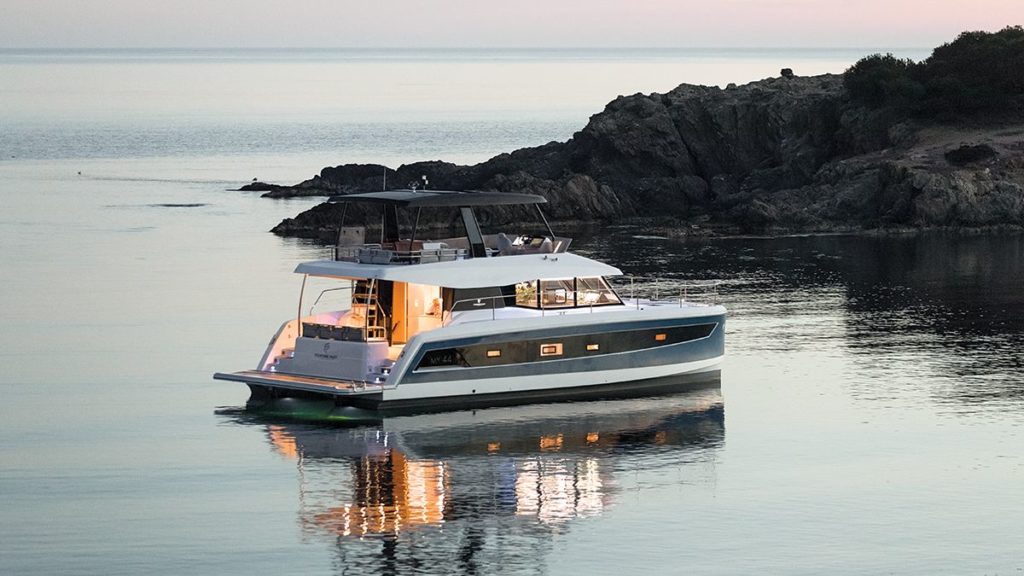
The Fountaine Pajot MY44 , a creation of Italian architect Pierangelo Andreani and French designer Daniel Andrieu, has a main deck that’s open from the aft-deck seating all the way forward to the starboard helm station. The sense of spaciousness is significant, for several reasons. First, four glass panels aft can all slide to port, creating an indoor-outdoor space with the aft deck and salon. In the salon, 32-inch-high windows extend for 12 feet down the sides of the yacht, with three sections per side, bringing in natural light along with the three forward panes that comprise the windshield. Finally, 6-foot-6-inch headroom provides vertical clearance, with a 21-foot-7-inch beam that adds interior roominess while keeping the yacht stable.
Read more: Fountaine Pajot MY44
Silent-Yachts 55
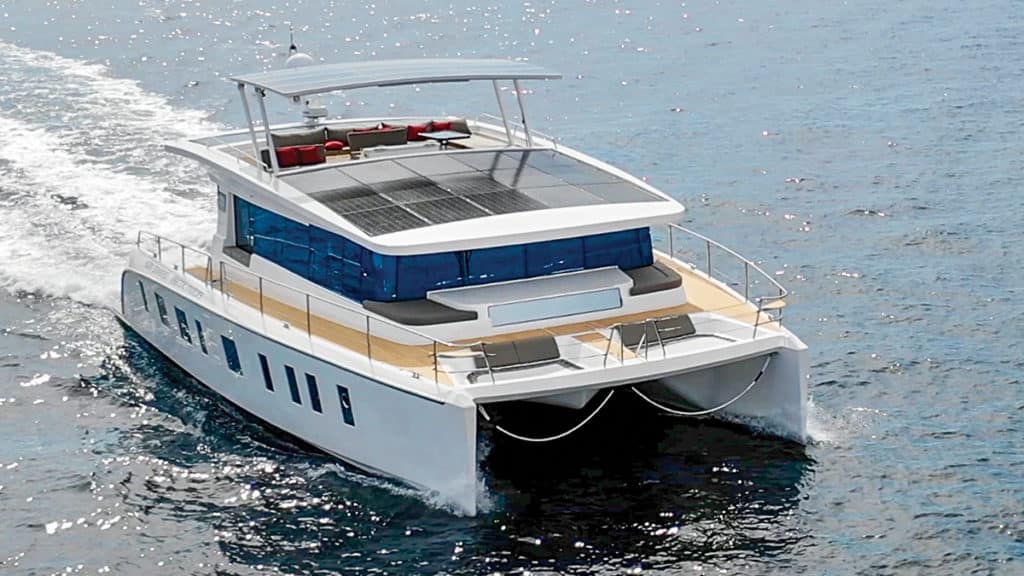
The ideas about which solar panels, electric motors, inverters and the like to use — and more importantly, Michael Köhler says, how to configure them — became the basis for the brand Silent-Yachts. The company offers 55-, 64- and 79-foot catamarans that run on solar-electric propulsion. The Silent 55 premiered this fall, and the 64 is sold out for the next two years, Köhler says.
Read more: Silent 55
Horizon PC74
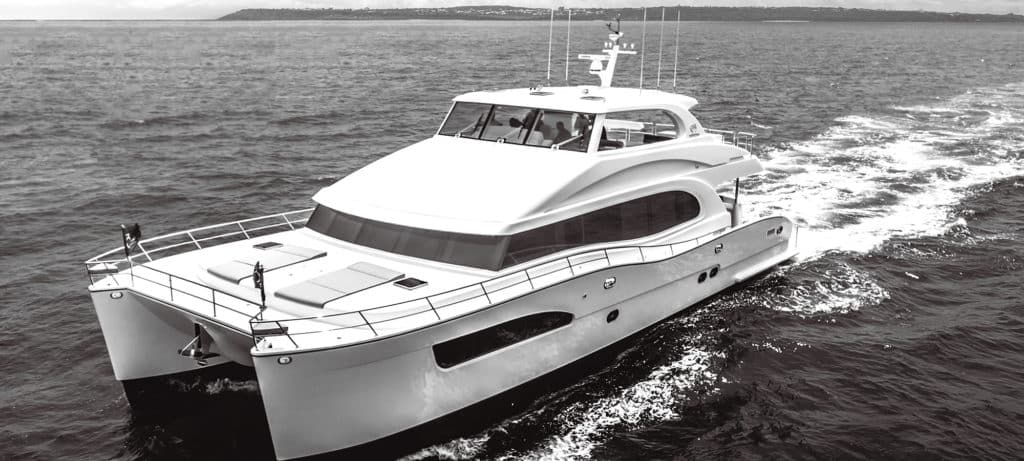
As founder and director of The Powercat Company, a Horizon Power Catamarans distributor, Stuart Hegerstrom had long believed that catamaran builders needed to design their yachts to more stylish standards.
“The boats were very boxy,” he says, based on his years of experience with cats in the charter market. He and his partner, Richard Ford, asked Horizon to produce models that had high-end finishes and looked good inside and out.
The Horizon team brought in mega-yacht designer JC Espinosa to work with its own craftsmen. The result aboard the Horizon PC74 is a catamaran with exterior styling, layout and functionality that should appeal to private and charter owners alike.
Read more: Horizon PC74
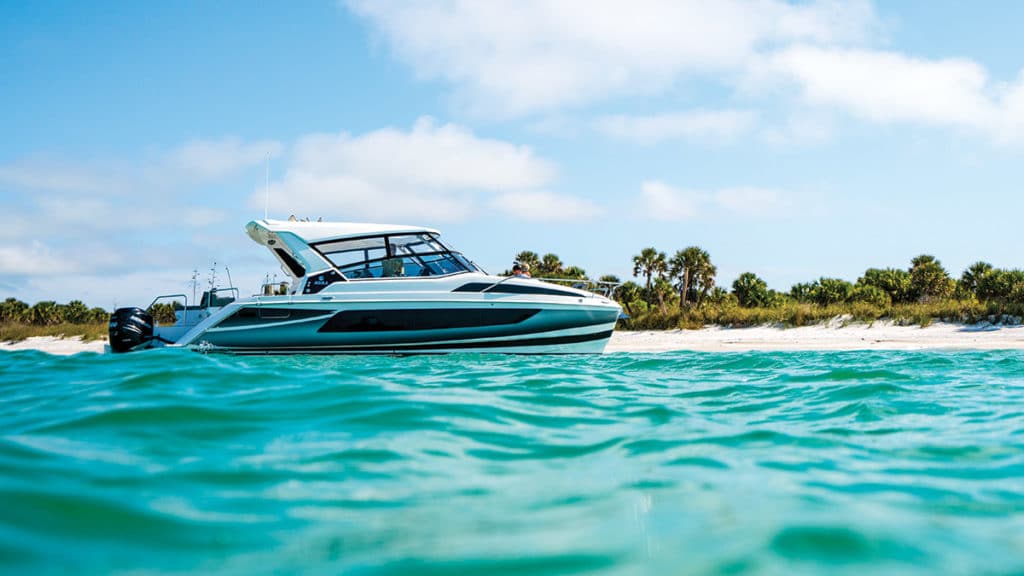
The Aquila 36 is a departure from her sisterships in that she is an outboard-powered, express-cruiser-style catamaran, but she also adheres to MarineMax’s philosophies.
With a single main living level from bow to stern and a beam of 14 feet 7 inches, the Aquila 36 is like a bowrider on steroids. She has seating that can handle 20 adults for outings and barbecues, and there are two staterooms below, one in each hull, for family weekending. The staterooms have nearly queen-size berths, en suite heads, stowage and 6-foot-6-inch headroom.
Read more: Aquila 36
Lagoon Seventy 8 Powercat
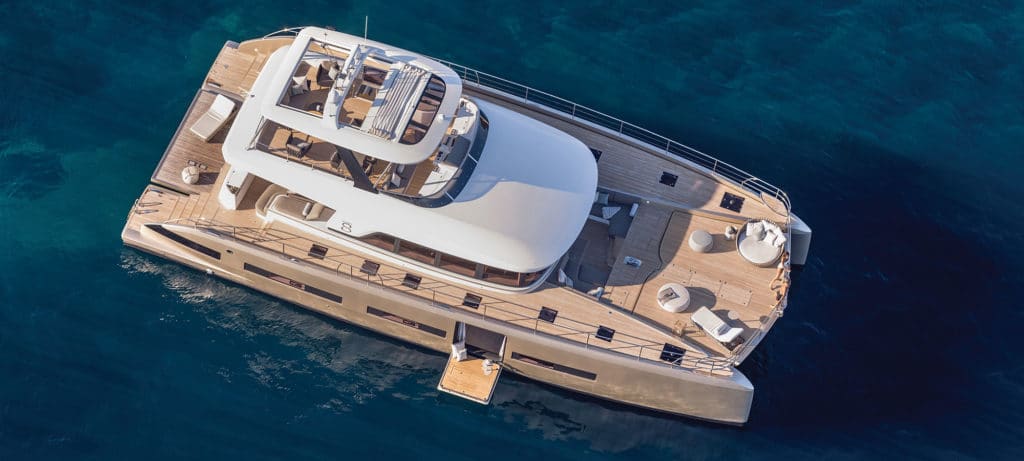
Lagoon is a division of Groupe Beneteau, the world’s largest builder of sailing yachts, and the Lagoon Seventy 8 Powercat is a developmental sistership of its Seventy 7 super sailing cat. The Seventy series yachts are built at Construction Navale Bordeaux in France, which had to add a new yard to construct these catamarans because they require separate stern molds for the power and sail versions.
Read more: Lagoon Seventy 8 Powercat
Horizon PC60
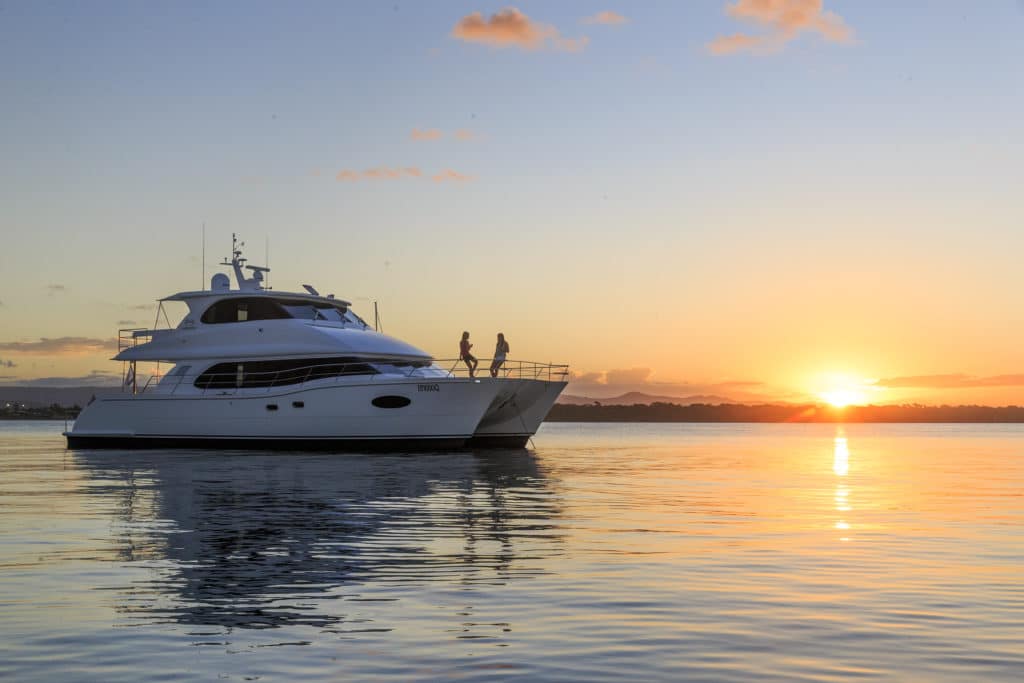
To understand the Horizon PC60 power catamaran , you need to put aside preconceived notions about midsize yacht amenities. For example, main-deck master suites are the province of yachts over 100 feet length overall. Incorrect. This 60-footer has an elegant and spacious owner’s stateroom on the same level as the salon. If you want a 14-foot center console tender on a 60-foot yacht, you have to tow it. Wrong again. On the PC60, you hoist it onto the upper deck, no problem.
Read more: Horizon PC60
40 Open Sunreef Power
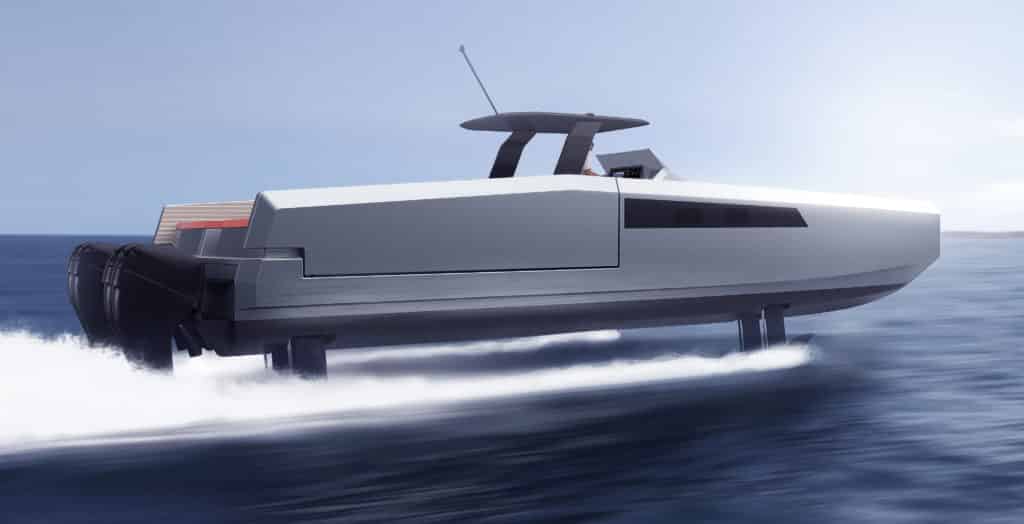
Sunreef is known for pushing the boundaries of catamaran design, incorporating four adjustable hydrofoils into a twin-hulled speedboat.
The Polish builder is one of several European builders (including Evo, Fjord, Wider and Wally) transforming the open day-boat category with creative designs. Beyond its hydrofoils, the 40 Open Sunreef Power ‘s cockpit has side “wings” along the aft gunwales that fold out at anchor, widening the beam from 17 feet to 22 feet 9 inches.
Read more: 40 Open Sunreef Power
Sunreef 50 Amber Limited Edition
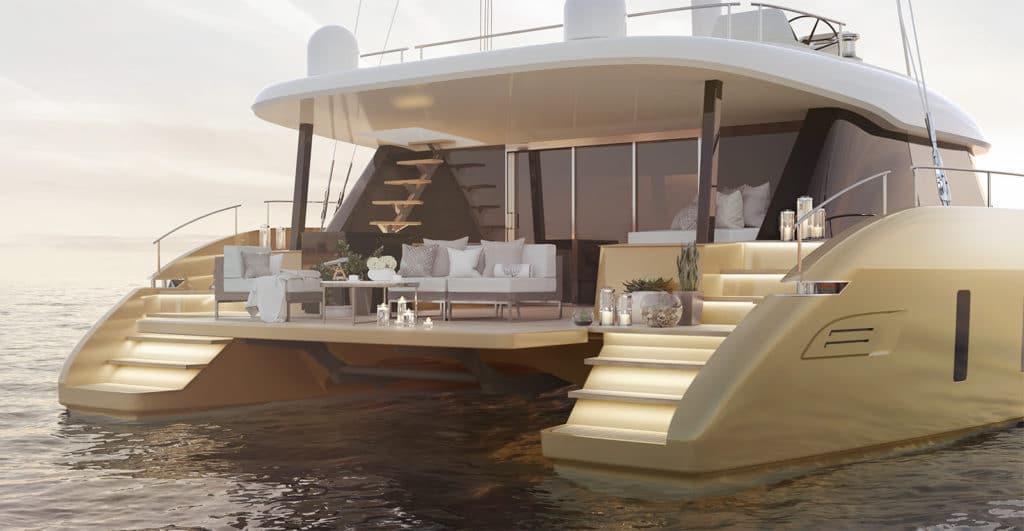
Sunreef Yachts introduced its 50 Amber Limited Edition , with plans to launch just 10 hulls of the exclusive design.
The Sunreef 50 Amber Limited Edition will have a carbon fiber mast and boom, four layout options and numerous amber-colored elements, including the hull.
Read more: Sunreef 50 Amber Limited Edition
Lagoon 630 Motor Yacht
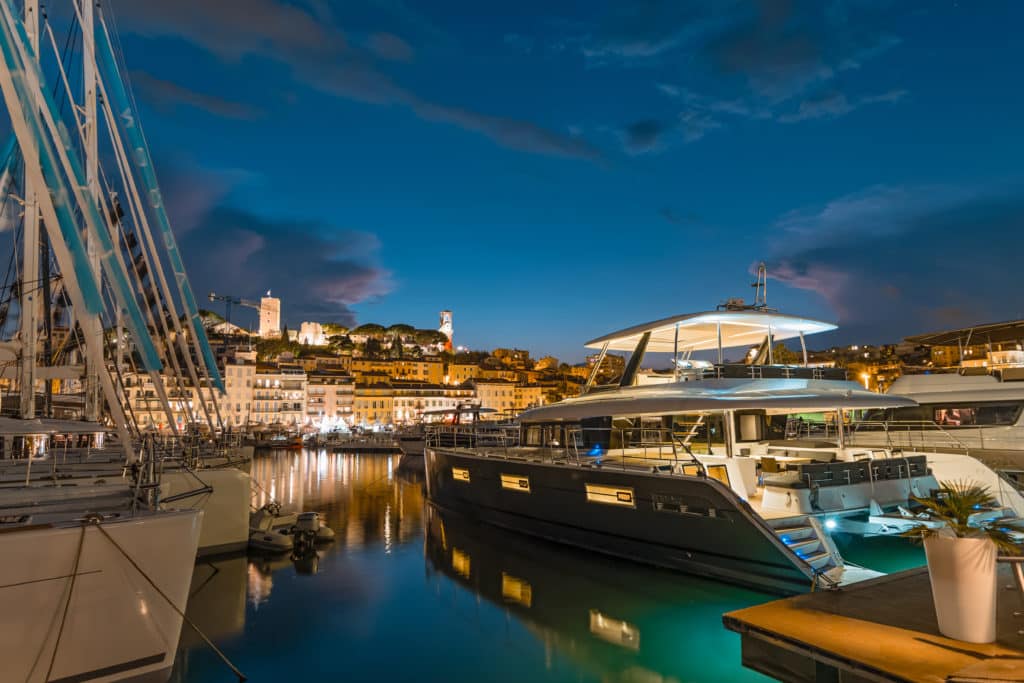
Fitted with the optional twin 300-horsepower Volvo Penta D4 diesels, the Lagoon 630 MY burns only 1.64 gph total at 6 knots, giving a theoretical range of 2,952 nautical miles with standard tankage of 793 gallons. Hull No. 1 had an optional 502-gallon tank, giving it transatlantic range.
Luxury, stability and economy are all hallmarks of Lagoon’s return to luxury motor yachts. If you can take a ride, it will be worth your time.
Read more: Lagoon 630 Motor Yacht
Fountaine Pajot MY 37
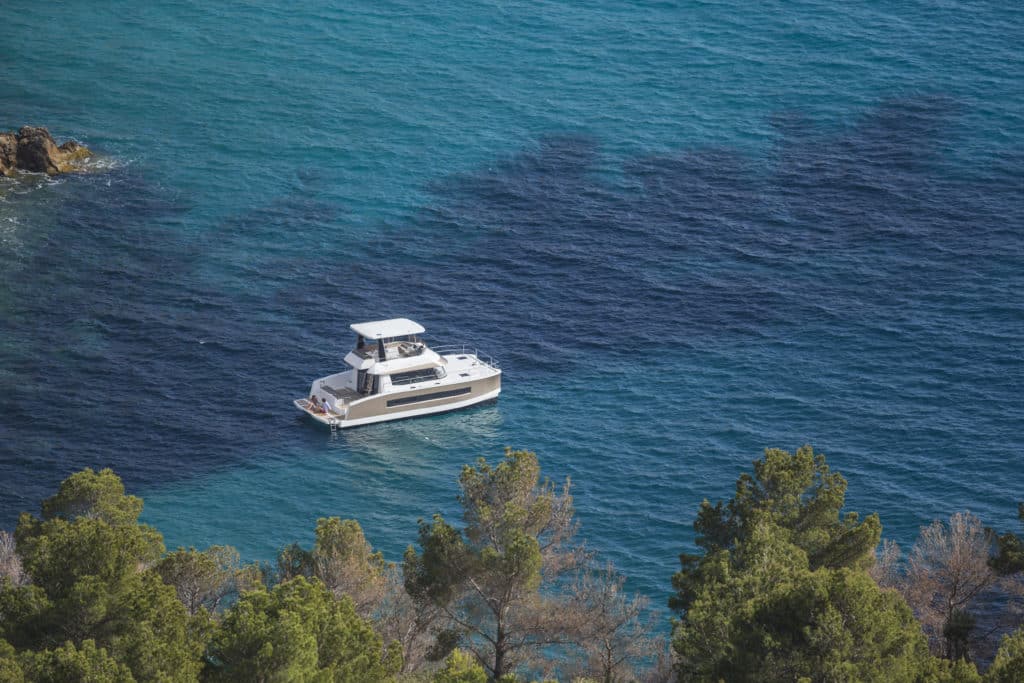
The Fountaine Pajot MY 37 easily accommodates the seafaring family with three- and four-stateroom options. In the three-cabin version, called Maestro, you’ll find an owner’s suite in the portside hull with a queen-size berth and en suite head. Two double-berth cabins and one more head are available for the kids. If your brood is bigger, the Quator setup features four double cabins with two heads.
The 37 is a traveler and can be powered with twin 150 hp or 220 hp Volvo Penta diesels. Top speed with the smaller engines is 17 knots, while it’s 20 knots with the bigger power plants. Interestingly, at 7 knots, the fuel consumption is the same, with either set of motors offering voyagers a 1 ,000-nm range.
Read more: Fountaine Pajot MY 37
Solarwave 64
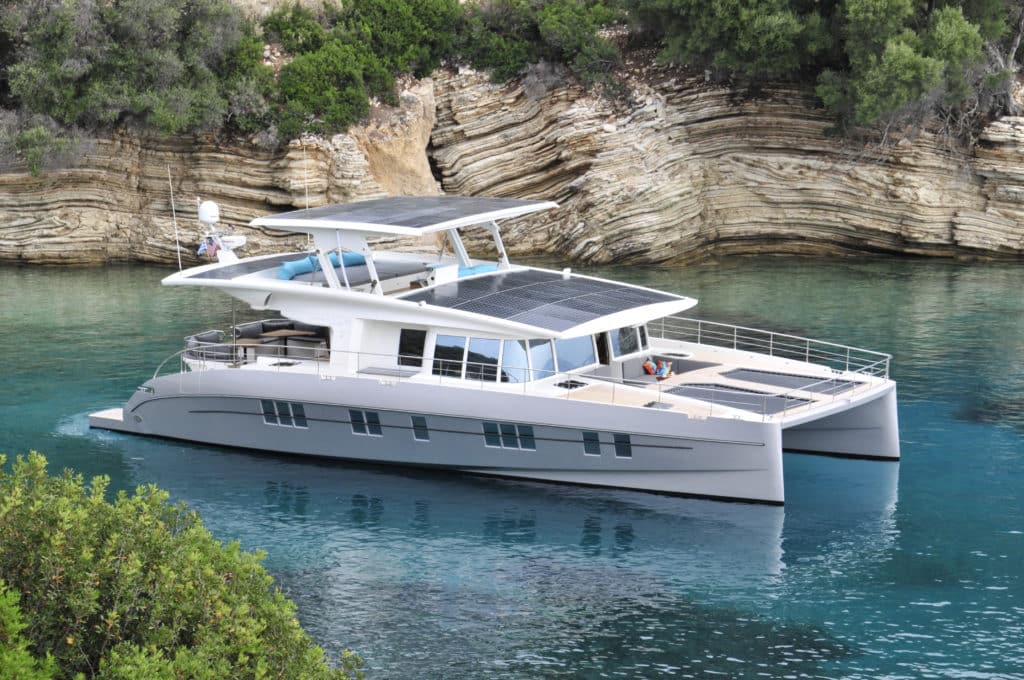
Many yachts boast eco chops because they have a handful of solar panels that power the microwave or navigation lights. The Solarwave 64 , launched last summer, has the potential to run on sunshine alone. The vessel’s 42 solar panels generate 15 kW that are stored in batteries weighing about 1,300 pounds. They connect to electric motors.
Read more: Solarwave 64
Glider SS18
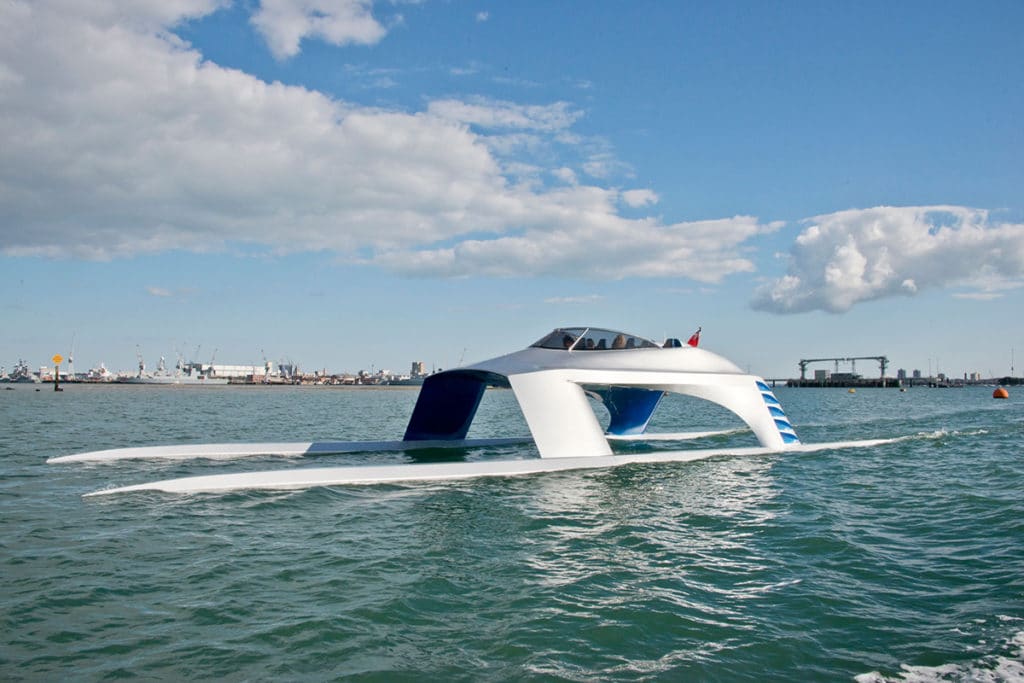
This British builder says it strives for design innovation and the Glider SS18 displays that DNA, the result of 8 years of research and development. She has a head-turning, catamaran hull form constructed from aluminum and composite materials. She is 60 feet LOA with a 17-foot beam, and has a relatively shallow 1-foot draft. Powered by quad Yamaha 300 hp outboards, she can reportedly reach 50 knots, and with her Stability Control System (SCS), should give a smooth ride while doing it.
Read more: Glider SS18
- More: aquila , Aquila Boats , Express and Flybridge Cruisers , Fountain Pajot , Glider Yachts , Horizon Power Catamarans , Lagoon , Power Catamarans , Silent-Yachts , Sunreef , Yachts
- More Yachts
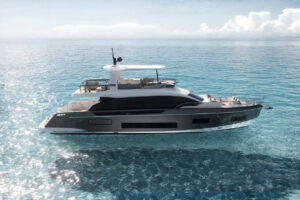
Azimut Launches the Fly 62

Sunseeker Predator 75 Reviewed

Meet the Emissions-Free Colombo 25 Super Indios E
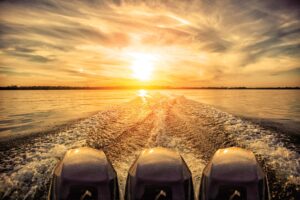
Offshore Fishing Boats and Insurance Prices

For Sale: Hargrave 96 Skylounge

Reflections on Offshore Sailing

For Sale: Outer Reef 720

For Sale: Prestige 620 Fly

- Digital Edition
- Customer Service
- Privacy Policy
- Terms of Use
- Email Newsletters
- Cruising World
- Sailing World
- Salt Water Sportsman
- Sport Fishing
- Wakeboarding

ArrowCat Power Catamarans Unmatched Craftsmanship Meets Unyielding Spirit
Experience the thrill of the open water with unparalleled comfort and tailored craftsmanship. Whether you are cruising the coastlines or anchored in serene bays, your ArrowCat power catamaran is your gateway to a life of adventure and tranquility.
Introducing Our Newest Addition, The 20' Power Cat Center Console Model
We intentionally designed this model to be simple and plain – simple to take the boat out, simple to use and to maintain, plain by allowing you the flexibility to customize it according to your preferences.
ArrowCat 20cc
This 20-foot center console is built with strength and purpose, designed for ease and simplicity. Effortlessly take it out on the water, and enjoy straightforward maintenance and operation. Its clean, adaptable design allows for extensive customization, whether on your own or through a dealer.
Fully Planing Hull Design LOA: 19′ 4″ / 5.89 meters Beam: 8′ 4″ / 2.54 meters Draft: 10″ / 0.254 meters
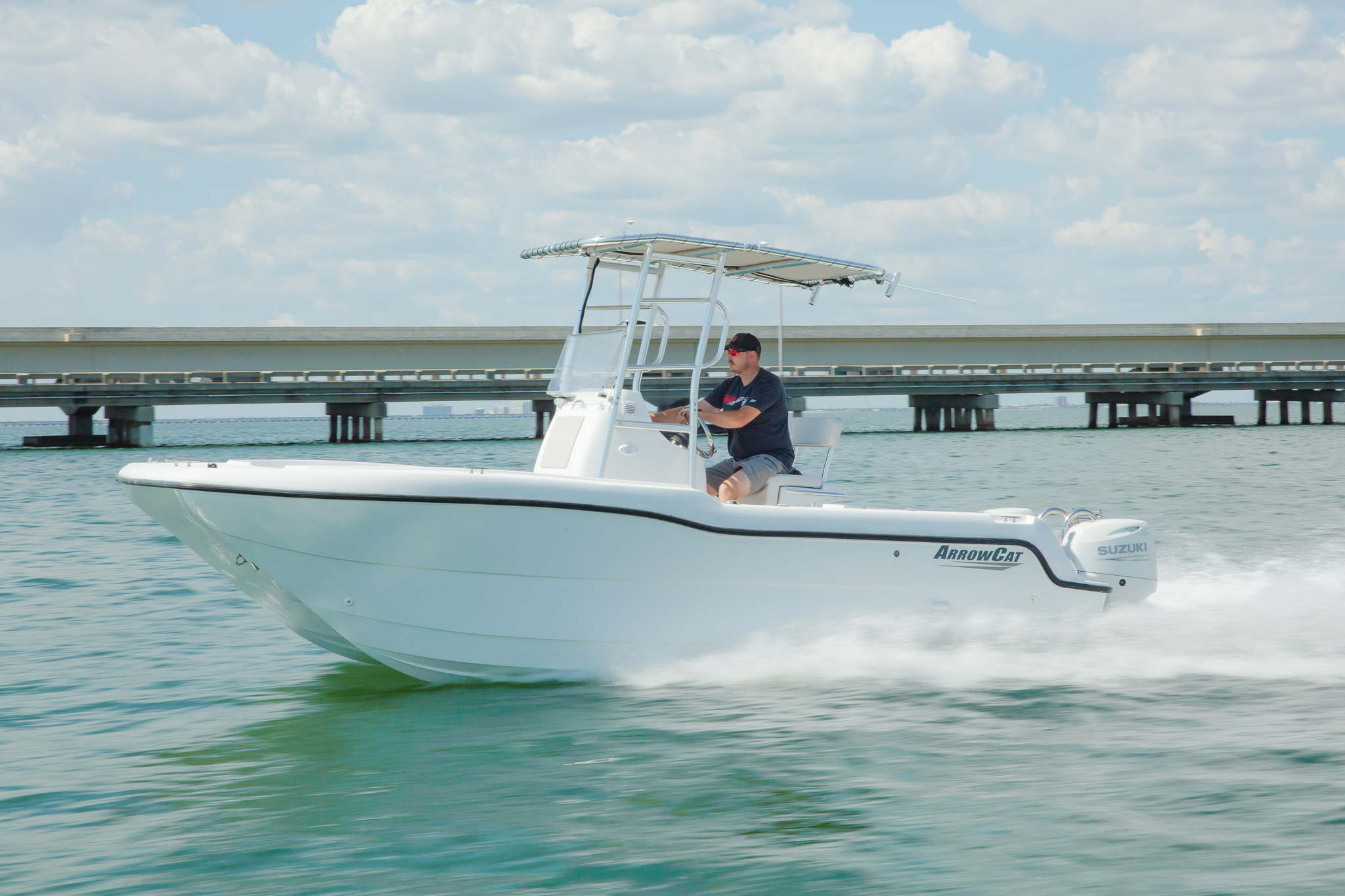
Explore Our 32' and 42' Signature Cabin Models
Perfect for inshore and offshore cruising, long distance and overnight trips, cold off seasons and hot boating seasons, and much more. The ArrowCat 32-foot and 42-foot models provide an exciting and versatile experience on the water. Explore to see which one could best suit your boating lifestyle.

ArrowCat 320
Merging express cruiser elegance with catamaran stability, the ArrowCat 320 Coupe features a planing hull design for smooth, swift rides. Powered by twin outboard motors, it promises dynamic performance and exhilarating adventures on every voyage.
Standard Layout: 2 Cabins/ 1 Wet Head Optional Tower Option LOA: 31′ 2″ / 9.5 meters Beam: 10’ / 3.05 meters Draft: 20″ / 0.508 meters
ArrowCat 420 Coupe
The ArrowCat 420 Coupe combines the luxury of an express cruiser yacht with the stability of a catamaran hull. Designed with a planing hull for agile, efficient navigation and powered by twin outboard motors, it delivers unmatched performance for your ocean adventures.
Standard Layout: 2 Cabins/ 1 Full Head LOA: 41′ 9″ / 12.73 meters Beam: 14′ 9″ / 4.50 meters Draft: 18″ / 0.46 meters

ArrowCat 420 Flybridge
This luxury express cruiser yacht boasts a catamaran hull for superior stability and a planing hull design that ensures efficient, agile handling. Powered by twin outboard motors, it offers robust performance. The addition of a flybridge enhances your view and enjoyment, making every journey unforgettable.
Standard Layout: 2 Cabins/ 1 Full Head LOA: 41′ 9″ / 12.73 meters Beam: 14′ 9″ / 4.50 meters Draft: 20″ / 0.51 meters
Our Unique Design
Enjoy your boat year-round and stay warm and dry during cooler weather or overnight trips, while also having a comfortable and private space to retreat for whenever you need a break. Here are a few reasons why an ArrowCat power cat is an excellent boat to consider.
Catamarans have two hulls, which provide more stability in the water. They are less likely to roll or pitch, which means they offer a more comfortable ride, especially in rough conditions and for people who are prone to seasickness.
Power catamarans are typically more fuel-efficient than monohull boats of the same size. It requires less energy and yields more performance per HP. The two hulls create little to no drag or resistance to get on plane, resulting in greater fuel economy. Allowing for longer journeys with fewer refueling stops.
Power catamarans have a shallow draft which means they can navigate diverse cruising grounds – beaches, islands, rivers, channels, and coastal areas with limited water depth.
Express Cruiser
Cabin boats are designed with comfortable sleeping quarters and living spaces. They feature a sleeping space with a bed, a galley with a stove, sink, and refrigerator, and a head with a shower and toilet.
Cabin boats provide protection from the elements, such as wind, sun, and rain. This allows for comfortable cruising in a variety of weather conditions, as well as providing a haven during storms
Express cruisers are designed for efficient and fast navigation, offering higher speeds compared to traditional cruising boats. They usually have powerful engines that enable them to cover long distances quickly, making them ideal for day trips or weekend getaways.
Powered By Outboard Motors
Outboard motors can provide excellent performance and speed. They can often reach higher speeds than inboard motors of the same horsepower.
Outboard motors have a simple and standard design and are relatively easy to install, they do not require additional components such as a transmission, propeller shaft, couplings, and struts, that inboard engines do. They are easily assessable and cost less to maintain than inboard motors because they are mounted outside at the rear of the boat.
Outboard motors are often designed with features that make them easy to maneuver. For example, they can be tilted or rotated to provide precise control and handling in tight spaces and shallower waters.
About ArrowCat
Crafting Versatility and Adventure on the Water Since 2008
At ArrowCat, we believe in creating boats that are ready for anything. Our American-owned company builds versatile, multi-functional catamarans designed not just for a specific activity, but for a lifestyle that demands freedom and reliability. Whether you’re cruising, fishing, or exploring, our boats deliver superior performance in all conditions.
Trusted by seasoned mariners across coastal and saltwater environments, ArrowCat power catamarans embody the spirit of adventure and the promise of quality.
Learn More About Us
Experience A Smooth, Fast, And Stable Ride
Discover the unparalleled stability and speed of an ArrowCat power catamaran. Connect with our experts to schedule your sea trial today and experience the thrill firsthand.
Privacy Policy

How Fast Do Catamarans Go?

Last Updated by
Daniel Wade
August 30, 2022
Catamarans are known for their speed, and some vessels are fast enough to break world sailing speed records.
Catamarans can go between 15 and 30 knots, with the fastest achieving speeds well in excess of 60 knots. Sailing catamarans are sometimes twice as fast as monohulls and cut through the water with greater efficiency.
In this article, we’ll cover how fast catamarans can go based on factors such as size, sail area, and design category. Additionally, we’ll compare catamaran speeds to monohulls and trimarans and cover the reasons why multi-hull sailboats blow monohulls out of the water.
We sourced the information used in this article from sailing guides and hull speed calculations. Additionally, we sourced information directly from the manufacturers of common catamarans.
Table of contents
Catamaran Speed by Type
Catamaran design can be split into different categories. After all, different vessels are designed for different tasks, as speed isn’t always the most important design consideration.
The fastest type of catamaran is the ultralight racing catamaran. These vessels have extremely narrow hulls and a remarkable planing ability. They’re designed to pierce waves and often achieve speeds in excess of 45 knots or greater, depending on conditions.
The second fastest catamaran variety is the sport catamaran. Sport catamarans often include a fairly good level of creature comforts in the cabin. They’re technically hybrid designs, because they are envisioned as a combination between a racer and a cruiser. Sport catamarans can achieve 30 knots or greater.
Cruising catamarans are designed primarily for safety and comfort. They’re often used for long offshore passages, where speed is important, but comfort is king. Despite their accommodations, cruising catamarans can still achieve a respectable 15 to 20 knots of speed—sometimes 50% faster than similarly-equipped monohulls.
Why are Catamarans So Fast?
Catamarans are remarkable vessels that can achieve amazing speeds. As a result of their unconventional design, typical calculations for hull speed (such as those used for monohulls) don’t always apply.
But what makes catamarans so much faster than equivalent monohulls? The first and most obvious speedy design element are the hulls themselves.
Catamarans don’t have a deep keel or a centerboard. This is because the second hull acts as a stabilizing device, and it helps the vessel track straight. The lack of a keel reduces weight (and equally important). It also reduces drag.
Additionally, catamarans behave in strange ways while underway. The hulls have a tendency to rise out of the water further the faster they go. This further reduces drag and makes it easier for the vessel’s speed to climb once it starts to move.
One additional characteristic is how the vessel’s sails point relative to the wind. Catamarans keep their sails perpendicular to the wind, which allows them to harness energy more efficiently. This is because, at a perpendicular angle, less wind energy is lost by spillage over the edge of the sails.
Are Catamarans Faster than Monohulls?
Yes, catamarans are typically faster than monohulls. They’re also a lot more stable, as their spaced-out hulls provide better motion comfort in rough seas. Catamaran hulls are narrower than monohulls, which also reduces drag and increases speed.
Catamaran vs. Monohull Speeds
We know that catamarans are faster than monohulls in most situations. But how much faster are they? Here’s a table of hull speeds for monohulls, which is a useful reference when comparing speed. Hull speed isn’t the absolute fastest that a boat can go, but it’s a good practical estimate for understanding the hydrodynamic limitations of single-hull designs.
Hull speed calculations for catamarans are more complicated. This is because catamarans have a greater length-to-beam ratio. And due to their narrow hulls and open center, they aren’t affected by the same hydrodynamic drag forces that monohulls are limited by.
For example, a 55-foot monohull sailboat with a waterline length has a hull speed of 9.4 knots or 10.9 mph. Its actual speed could exceed that in the right conditions, but rarely by more than a few knots.
Compare that to an efficient 51-foot catamaran, which can easily achieve speeds in excess of 20 knots in reasonable winds. That’s more than double the hull speed of a monohull with a similar waterline length and proves that catamarans operate under a completely different set of rules.
Wave Piercing
One aspect of catamaran design that makes them superior speeders is their ability to pierce waves. Specially designed catamarans have minimal buoyancy at the bow, which allows them to slice through waves instead of going over them.
This increases the speed at which catamarans can cover the distance. Think about it—a boat going over a wave has to use more energy to reach the same destination, as the height of the wave almost makes the distance further.
It’s like walking over a hill or on flat ground—you’ll take more steps walking up and down the hill than in a straight flat line. Wave piercing catamarans enjoy better stability, and they ‘take the flat road’ to a greater extent than monohulls.
Do Catamarans Plane?
Planing is when a boat’s hull rises out of the water due to hydrodynamic lift. This increases speed and efficiency, as there’s less drag but sufficient contact for stability. It also reduces rolling, as the bow only contacts the taller portions of the waves.
Catamarans have planing characteristics, but they generally don’t plane as dramatically as powerboats. This is still worth noting, as catamarans are specifically designed to use the phenomenon of hydrodynamic lift to gain speed and efficiency.
You’ll visibly notice a catamaran’s hull rising out of the water as it increases in speed. Compare that to a displacement monohull design (such as a classical cruising sailboat with a deep keel), which won’t rise out of the water in any significant way.
Are Catamarans Faster than Trimarans?
A trimaran is a catamaran with an additional hull in the center. Trimarans are usually less common than catamarans, but they have some of the same design benefits as other multi-hull sailboats.
At first glance, it would seem logical that trimarans are slower than catamarans. After all, they have an extra hull in the center, which likely increases weight and drag. However, there are more important factors at play here.
Trimarans are almost universally faster than catamarans. This has to do with weight distribution. Trimarans center their weight over the middle hull, using the outer hulls primarily for stability. This allows them to reap the benefits of a catamaran while increasing the efficiency of the wind power it captures.
Fastest Catamarans
Catamarans are popular for racing. There are several world records held by catamarans and numerous production boats with especially impressive speed-to-size ratios. Here are a few of the fastest racing and production catamarans ever built.
Fastest Sailboat Ever—Vestas Sailrocket 2
The Vestas Sailrocket is a specialized racing boat designed only for speed. This incredible vessel is actually the fastest sailboat ever built—and no wonder it’s a catamaran. A monohull simply can’t achieve record-breaking speeds when put head-to-head with a lightweight multi-hull.
The vessel, which earned the world sailboat speed record in 2012, has a modest 150 to 235 square feet of sail. Nonetheless, it managed to achieve a remarkable top speed of 65.45 knots in only 25 knots of wind. That’s about 72 miles per hour—in a sailboat.
Soon, a team of Swiss engineers will release their own version designed to beat the 65-knot speed record. Their vessel, which is a hydrofoil, will attempt to hit an incredible target speed of about 80 knots.
Outremer Catamarans
But what about production catamarans? How do they stack up, and how fast can they go? French boat builder Outremer Catamarans builds some of the fastest production catamarans ever built. These are not specialty racing boats—in fact, they’re average-sized cruising catamarans.
Let’s use the larger Outremer 51 as an example. This high-end cruising cat is known for its almost outrageous speed capabilities. In ideal conditions, owners of the Outremer 51 have reported speeds exceeding 20 knots for extended periods.
That’s a production catamaran with speeds that rival 20th-century warships. With such a fast boat, the world’s oceans start to appear a lot smaller. Plus, the genius design of the Outremer 51 allows it to be crewed by just two people.
But how do Outremer catamarans achieve such high speeds? The secret is in precise engineering and hull design, along with a sail plan that’s perfectly catered to the vessel. The hulls are sleek and narrow and designed to cut through the water with minimal drag.
From the bow, the Outremer 51 hulls look paper-thin. They increase in width gradually, which eliminates areas of sudden drag. These narrow hulls evenly distribute the vessel’s 21,825-lb displacement. Its low-buoyancy bows reduce drag and blast through waves instead of riding over them.
Related Articles
I've personally had thousands of questions about sailing and sailboats over the years. As I learn and experience sailing, and the community, I share the answers that work and make sense to me, here on Life of Sailing.
by this author
Learn About Sailboats
Most Recent

What Does "Sailing By The Lee" Mean?
October 3, 2023

The Best Sailing Schools And Programs: Reviews & Ratings
September 26, 2023
Important Legal Info
Lifeofsailing.com is a participant in the Amazon Services LLC Associates Program, an affiliate advertising program designed to provide a means for sites to earn advertising fees by advertising and linking to Amazon. This site also participates in other affiliate programs and is compensated for referring traffic and business to these companies.
Similar Posts

Affordable Sailboats You Can Build at Home
September 13, 2023


Best Small Sailboat Ornaments
September 12, 2023

Discover the Magic of Hydrofoil Sailboats
December 11, 2023
Popular Posts

Best Liveaboard Catamaran Sailboats
December 28, 2023

Can a Novice Sail Around the World?
Elizabeth O'Malley
June 15, 2022

4 Best Electric Outboard Motors

How Long Did It Take The Vikings To Sail To England?

10 Best Sailboat Brands (And Why)
December 20, 2023

7 Best Places To Liveaboard A Sailboat
Get the best sailing content.
Top Rated Posts
Lifeofsailing.com is a participant in the Amazon Services LLC Associates Program, an affiliate advertising program designed to provide a means for sites to earn advertising fees by advertising and linking to Amazon. This site also participates in other affiliate programs and is compensated for referring traffic and business to these companies. (866) 342-SAIL
© 2024 Life of Sailing Email: [email protected] Address: 11816 Inwood Rd #3024 Dallas, TX 75244 Disclaimer Privacy Policy
28' Eliminator Daytona ICC

28' eliminator 28 speedster

21' Eliminator 21 Daytona

30' AMT Cat

30' Spectre Cat

32' Spectre Cat

27' Eliminator 27 Daytona

36' Victory VTX

35' Motion cat

26' Nordic deck boats

28' Nordic 28SS

28' SHOCKWAVE DECK BOAT

36' Doug wright Carbon Edition

27' NORDIC THOR

28' ELIMINATOR DAYTONA LP

36' Eliminator Speedster

29' Carrera Cat Openbow

28' Conquest BOSS CAT deck boats

32' DCB F32

29' Force Offshore 29 Canapy Cat

28' Magic H Series Deck Boat

| --> --> |
fast outboard catamaran

More From Forbes
Gunboat 57 charter catamaran will spoil you with speed.
- Share to Facebook
- Share to Twitter
- Share to Linkedin
Gunboat 57 Vai Vai is not your average charter cat.
One of the many perks of my job as a yachting writer is that I get to sail aboard a wide variety of boats. I especially love ripping off speed runs aboard some the world’s largest (and fastest) offshore race boats . Now, the truth is, the only reason I’m allowed aboard is because I’m just a humble journalist. But the blistering speeds those boats are capable of is addictive.
And as someone who’s been lucky enough to sail more than my fair share of charter catamarans in the Caribbean, Mediterranean, French Polynesia and other bucket list destinations, I can say every charter cat I’ve ever been on has been a fantastic platform for living large in the tropics. They’re not particularly exciting to sail.
Gunboat 57 Vai Vai speeds in front of Newport's The Claiborne Pell Bridge
I’m also grateful to say that I’ve sailed on a few high-performance sailing catamarans like the Gunboat 57 Vai Vai . One of the many cool things about Vai Vai is that she’s capable of blow-your-hair-back speeds AND providing just the right amount living space and cruising comforts. But I never knew it was possible to charter something as fast and fun-to-sail as a Gunboat 57—in Newport, Rhode Island in the summer and Caribbean in the winter—until now.
Jeff Hager's Gunboat 57 will appeal to sailors who appreciate high performance sailing and stylishly ... [+] comfortable accommodations on a charter boat.
Best High-Yield Savings Accounts Of 2024
Best 5% interest savings accounts of 2024.
After spending a little time with the VaiVai’s owner Jeff Hager earlier this summer, all I can say is Vai Vai ’s speed potential makes it possible to cover way, way more ground than a more conventional charter boat. And since everyone (even the helmsman and sail trimmer can hang out in main bridgedeck area, and the catamaran never heels more than a few degrees) more speed doesn’t mean less comfort.
The Gunboat 57 is a powerful sailing catamaran with stylishly comfortable accommodations and an ... [+] indoor helm station
In fact, the indoor/outdoor living aboard Vai Vai is next level. The wrap-around windows provide protection from the high winds and spray such a fast boat produces. The 360-degree view is amazing while the massive roof provides essential sun protection. And the sheer size of the bridgedeck is soooo much bigger than what you’d find on a 57-foot monohull. And the nice thing about having the galley and living cabins in the hulls is that each cabin is particularly private.
But, let’s fact it. This boat will not appeal to anyone who rates a charter boat based on how over-the-top-“luxurious” the accommodations are. This is a high-performance sailor’s catamaran for people who don’t want to give up the sheer thrill of sailing on a charter.
The boat that will bring oysters and other raw bar staples out to your boat at anchor is one of the ... [+] many reasons to stop in Cuttyhunk on a charter aboard Vai Vai.
And if you’re lucky enough to book a week aboard VaiVai before she heads south in the fall, be sure to stop for oysters on the tiny island of Cuttyhunk. I guarantee you’ll beat every other sailing charter boat in Newport’s fleet.

- Editorial Standards
- Reprints & Permissions
Join The Conversation
One Community. Many Voices. Create a free account to share your thoughts.
Forbes Community Guidelines
Our community is about connecting people through open and thoughtful conversations. We want our readers to share their views and exchange ideas and facts in a safe space.
In order to do so, please follow the posting rules in our site's Terms of Service. We've summarized some of those key rules below. Simply put, keep it civil.
Your post will be rejected if we notice that it seems to contain:
- False or intentionally out-of-context or misleading information
- Insults, profanity, incoherent, obscene or inflammatory language or threats of any kind
- Attacks on the identity of other commenters or the article's author
- Content that otherwise violates our site's terms.
User accounts will be blocked if we notice or believe that users are engaged in:
- Continuous attempts to re-post comments that have been previously moderated/rejected
- Racist, sexist, homophobic or other discriminatory comments
- Attempts or tactics that put the site security at risk
- Actions that otherwise violate our site's terms.
So, how can you be a power user?
- Stay on topic and share your insights
- Feel free to be clear and thoughtful to get your point across
- ‘Like’ or ‘Dislike’ to show your point of view.
- Protect your community.
- Use the report tool to alert us when someone breaks the rules.
Thanks for reading our community guidelines. Please read the full list of posting rules found in our site's Terms of Service.

Prada's Patrizio Bertelli on His Sailing Ambitions for the Luna Rossa Project at the America's Cup
According to Britannica, the definition of passion is "a strong feeling of enthusiasm or excitement for something or about doing something." This description perfectly describes Patrizio Bertelli 's never-abated gusto for sailing and his ambition to win the America's Cup - although he contends it's persistence rather than passion that is "the true motor."
For the past 25 years Bertelli has been investing in the Luna Rossa project to the tune of hundreds of millions of dollars, building increasingly technologically advanced sailboats and contributing to shaping the history of the prestigious competition.
The latest iteration of the Luna Rossa Prada Pirelli AC75 foiling monohull was christened in April in the Sardinian town of Cagliari by his wife, designer Miuccia Prada, as is the tradition. The boat is set to compete in the 37th edition of the America's Cup sailing race, which is taking place between Aug. 22 and Oct. 27 in Barcelona.
Decked in a metallic "Metal K"-colored livery, the AC75 marks the 10th Luna Rossa America's Cup hull unveiled since the first boat in 1999.
Built at the Persico Marine shipyard in Nembro, Italy, the sailboat, made of pre-preg carbon fiber, required 70,000 hours of work by 35 boat builders. It is equipped with a 25.6-meter mast with a soft wing comprising two twin mainsails and a headsail made of carbon and Dyneema.
At the time of the christening , Bertelli, chairman of the Prada luxury group and president of Luna Rossa Prada Pirelli, said the boat has "become an iconic name in sailing worldwide" and that he had accomplished the goal "to create a team of extraordinary technicians and sailors capable of shaping the future of sport in our country and leaving a legacy for future generations."
The upcoming America's Cup will mark Luna Rossa's seventh challenge, but sixth race. The team withdrew from the competition in 2015 after disagreeing with the overturning of rules that had been unanimously adopted the previous year by the then-Cup holder the Oracle Team of the U.S., which was owned by Larry Ellison. The Oracle team eventually lost the America's Cup to the New Zealand team.
This year, five challengers in the Louis Vuitton Cup regattas - Ineos Britannia, Alinghi Red Bull Racing, Luna Rossa Prada Pirelli, NYYC American Magic and Orient Express Racing - will battle it out on the water to win the right to face off against defender Emirates Team New Zealand for the Louis Vuitton 37th America's Cup Barcelona.
The Luna Rossa team was established in 1997 by Bertelli with the original name of "Prada Challenge for the America's Cup 2000." The team won the Louis Vuitton Cup in 2000, with a record of 38 victories over 49 races. It also competed in 2003 and in 2007, when it reached the Louis Vuitton Cup final.
Luna Rossa won the most recent Challenger Selection Series, the Prada Cup, in 2021 but lost to contender Emirates Team New Zealand, which succeeded in defending the 36th America's Cup with a 7-to-3 victory over Luna Rossa Prada Pirelli, wrecking the latter's ambitions to take the trophy home.
Here, Bertelli explains why the America's Cup continues to hold his interest, reveals his expectations for this year and talks about the lessons learned through the different stages of the competition.
WWD: Beyond your passion for sailing, what moves you to continue to invest in Luna Rossa and in the America's Cup? When did you first think you wanted to participate once again?
Patrizio Bertelli: After the last edition in Auckland [New Zealand] I immediately said we would continue even without knowing at the time where the next challenge would take place. The Cup fascinates me because it's a difficult, complex project that requires to develop a team of highly professional individuals super specialized in many different sectors that know how to unite and work together in harmony for a long period of time at a pace that is very intense. It's a difficult structure to set up but even more to manage.
WWD: How does this reflect on you personally and what did you learn over the years from the past experiences?
P.B.: Since the first launch in Punta Ala [Tuscany], 25 years have passed and the enthusiasm is the same. As [Sir] Peter Blake wrote in the foreword to the first "Luna Rossa" book [on the 30 th America's Cup in 2000] it is the difficulty to win that makes the America's Cup so unique. Time is not important, it's necessary to have the courage to continue to try and not give up. This curious and strange game requires persistence to reach the objective and it is the difficulty that gives meaning to the challenge. Passion has nothing to do with it, persistence is the true motor and behind this obstinacy is all the technological research that over these past years brought an enormous development to the world of sailing and repercussions also on daily sailing. It's a continuous challenge where you learn something every day.
WWD: How does all this affect Prada and the brand's products?
P.B .: There wouldn't be enough time to explore this in this interview, I would rather go back to talk about Luna Rossa.
WWD: How has Luna Rossa changed and how has the project changed over the years?
P.B.: Everything has changed if we look at all the challenges we took part in. In the first three challenges we sailed with the traditional IACC [International America's Cup Class yachts], which today seem almost prehistoric where the team was engaged in changes of sails at every lap and the regattas were stretched on for hours. Then the era of catamarans started with the 34th edition in San Francisco, fast boats with winged masts and rigid sails similar to wings of airplanes. Now from the last Cup, in 2020, we sail with flying boats that travel at more than 40 knots and that have only the helm and the lateral foils in the water. You don't change the sails, the regattas are very fast, they last around half an hour, and tactics and strategies have been revolutionized. The regatta field is limited by virtual boundaries, so it's entirely another story. But this is the America's Cup, the most advanced expression of this sport.
WWD: Some sponsors have also changed, and Oakley for example has joined as the new technical performance partner. Can you tell us abut the relationship with those who believe in the project with you, including skipper and team director Max Sirena?
P.B.: Our storied sponsor Pirelli has stayed on and I think the relationship with Marco Tronchetti [Provera, executive vice president of Pirelli, the co-title sponsor of the team] is increasingly more solid. Also Panerai and Woolmark have renewed their confidence in the team because they believe in it. We have two new sponsors, Oakley and Unipol. In addition, on the sails are now the logos of UNESCO and Sea Beyond, the educational project aimed at the protection of the oceans, born from a collaboration between our group and UNESCO. Then there are the suppliers that have a fundamental role in the project and with which the relationship developed over the years has increasingly strengthened. They represent Italian excellence and have obtained global recognition also thanks to Luna Rossa. With Max the relationship is excellent and consolidated, he has all my trust.
WWD: What are your thoughts now on Luna Rossa and the team? What has impressed you the most so far and how has the team evolved in parallel with the changes of Luna Rossa?
P.B.: Ever since the first challenge in 2000 we have invested a lot in our team because I think it is fundamental to compete at these levels. We have focused on the human relations, creating a community of interests that has generated strong and close-knit relations. There have been weddings, children, people that went to other teams and then returned recognizing the human quality of the relations within our team. Naturally in 25 years many things have changed to adapt to the evolution of the challenge and especially of the boats and the technology, even if a storied nucleus is still present.
Once we had a group of more than 30 sailors because we trained with two boats and there were 16 on board. Today they are eight - two helmers, two flight regulators and four cyclists who, pedaling, produce the energy for the functioning of all the systems aboard. Instead, the design team has increased exponentially with the evolution of the boats and the systems. We have inserted AI, mechatronics and simulators.
The shore team has also changed. Today there is a true dockyard within the base, where we have realized both the hull for the LEQ 12 [less than or equal to 12 meters] training, the masts of Luna Rossa and many other parts of the boat.
WWD: How do you think this evolution will impact the sailing world?
P.B.: The impact is already visible on daily sailing. Today if you don't have a foil, from the sailing boards on, you are a "nobody." I think this course has been very fascinating for the new generations who find an added pleasure in speed.
WWD: What do you think about the other teams?
P.B.: It's premature and I don't like to talk about others. Surely they are all very well-prepared also because if you think you are not, it's best to give up. It is a very cynical competition because you work for years and then only one of us challengers will acquire the right to participate in the America's Cup against the New Zealanders.
WWD: Do you think you will be present in Barcelona for the whole time? What are your expectations?
WWD: Do you continue to sail?
P.B.: Certainly, whenever I can, I like to stay on the open sea and navigate.
WWD: I know you collect boats; can you tell us about this?
P.B.: It's a great passion, I very much enjoy it. I am fascinated by the restoration phase. We try to safeguard as much as possible the originality of the construction and return the original beauty and function to the boats. I also very much like to race with them. Today, modern boats require professional crews who need to be very well-prepared athletically. Instead, vintage boats allow me to race and have fun with a team of friends led by [Olympic Brazilian sailor] Torben Grael.
This year, we were gratified by winning both the 12 mR Pre-Worlds at Saint-Tropez as well as the 12 mR World Championship in Porquerolles [France] with Kookaburra II, a world championship we won twice before with Nyala and once with Kiwi Magic KZ 7.
More from WWD
- FMG President Amanda Smith Chats WWD Weekend and Its Luxury Evolution
- Galliano, Anderson and Prada In for 2024 Fashion Awards Nominations


8 Best Catamarans That Are 30 Feet or Less
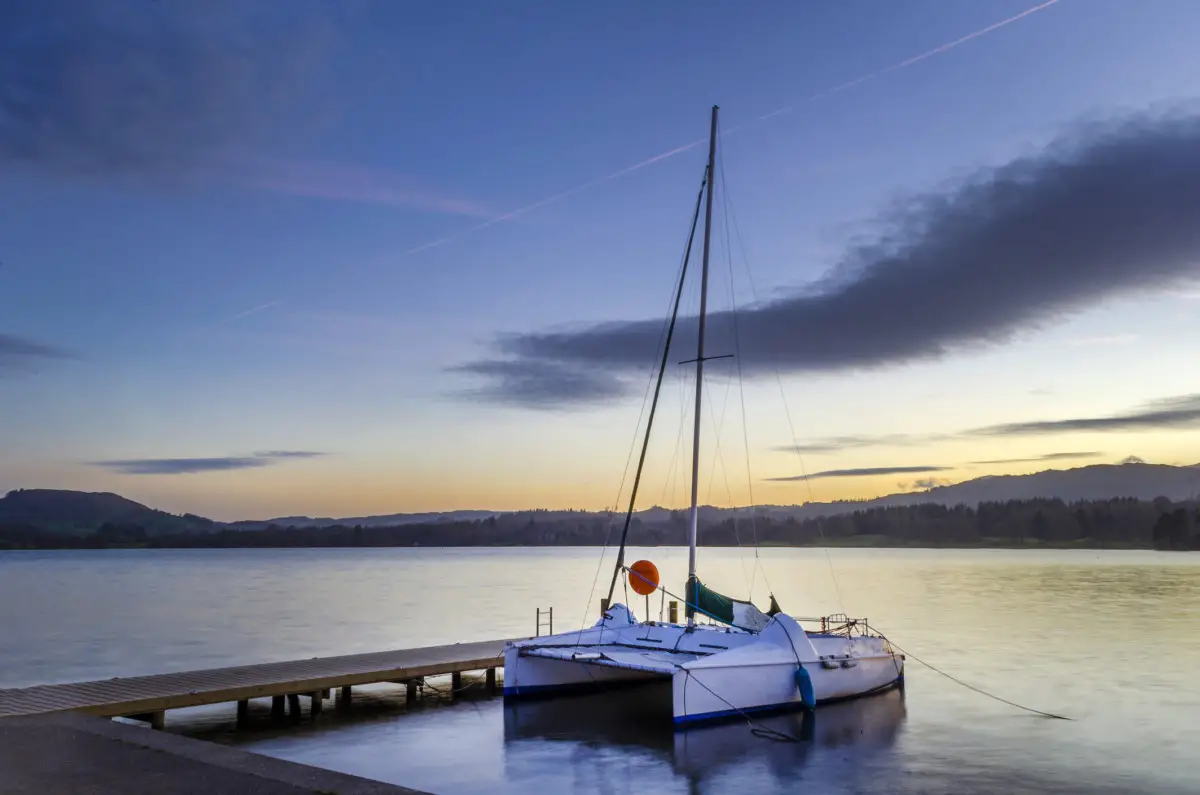
As an Amazon Associate, we earn from qualifying purchases. We may also earn commissions if you purchase products from other retailers after clicking on a link from our site.
Large-sized catamarans are appealing due to their ample spacing and comfort. Therefore, a cruising family or couple looking to buy a boat is more likely to go for one of these. But are there small cruising catamarans that provide the performance, comfort, and amenities found in larger boats?
The best catamarans under 30 feet (9.14 m) include the TomCat 6.2, Cadillac 27and 30, Gemini 30, Endeavour 30, and Maine Cat. These time-tested cruising cats are easy to handle, premium built, and are great for daytime sailing, overnight trips, and some even suitable for long-range sea passages.
In this article, you’ll find a list of the best cruising catamarans below 30 feet (9.14 m). Keep reading to discover which catamarans make this list, what they have to offer, their pros and cons, and how much they cost.
If you are unsure whether or not 30ft is too small for your needs, then I suggest you check out another article I wrote named Best Size Catamaran , it will discuss why length matters and how it affects safety.
Unlike most catamarans designed for racing purposes, the TomCat 6.2 is a medium-sized cat that’s well-suited to daytime cruising. It boasts high-quality construction, vacuum-bagged hulls, and a plywood-reinforced deck.
This 20 footer (6.09 m) comes with an 11-foot (3.35 m) beam and not only offers you safety and comfort but performance and versatility as well.
This boat has a centrally placed outboard engine and two rudders that allow it to turn quickly and maneuver confidently into and out of marina slips. The 9.9 hp outboard propels it to speeds of around 8 knots (9.21 mph or 14.8 kph), though the boat has the potential to move faster if desired.
This simpler type of cat (just one engine as an example) also allows for cheaper and easier maintenance. Maintenance costs are something most people underestimate when getting a cat, if you want to get some real numbers from actual sailors then I suggest you read this article (How much does it cost to maintain a cat).
The boat sails with minimal heeling, comfortably accommodate 6-8 people, and you can sail it single-handed or take a crew.
High and narrow hulls bearing arched bottoms allow for a low wetted surface. The hull design provides low resistance and a great deal of reserved buoyancy and also enables you to drive through closely spaced waves.
On most 20-footers (6.1 m), driving through waves generates a smooth but wet ride, but with the TomCat’s enclosed deck (link to parts names explained here ), you are safe and protected behind a windshield and the high bulwark.
The TomCat makes an excellent cruiser because it performs impressively well both under sail and power. It combines the performance of a modern sailing cat with the comfort, style, and convenience of a powerboat. It’s also trailerable since you can detach the hulls from the deck , winch up the deck on a trailer, and slide the hulls underneath.
But the best part is that it’s easy on the pocket, with the price ranging between $36,750 and $44,580 .
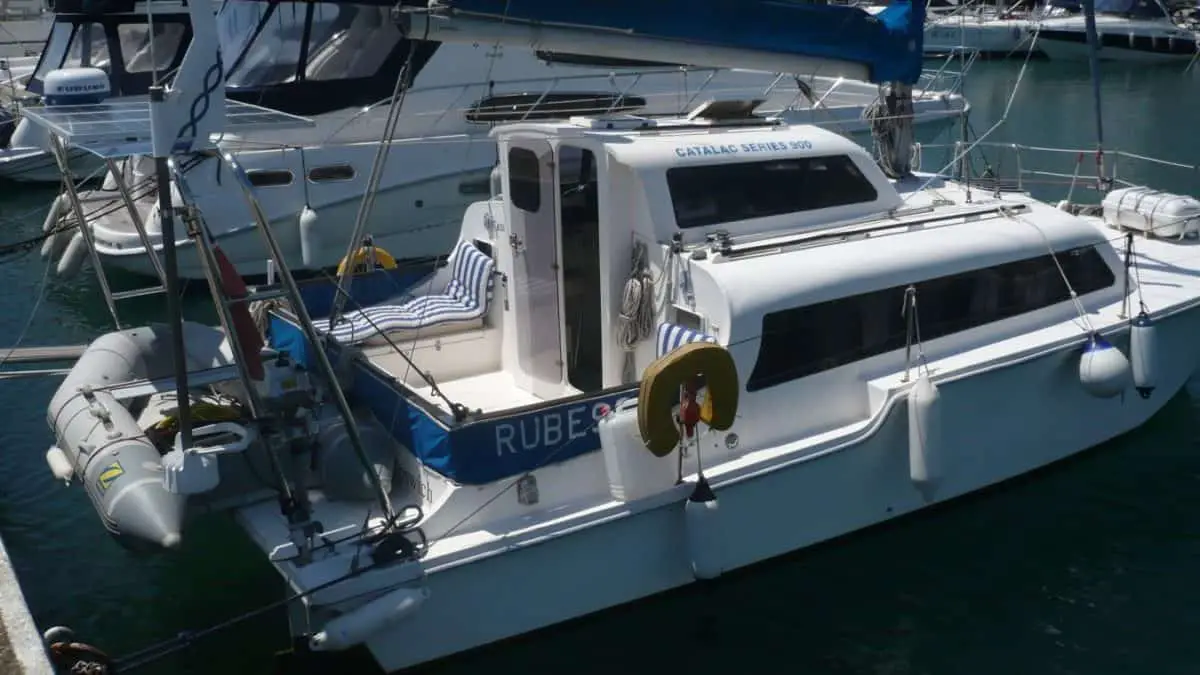
Catalac 30 (9M)
The Catalac brand consists of strongly built vessels that sport thick hulls, glass windows, narrow beams, and vertical transoms . Catalac 30 was the first vessel in this popular British cruising line designed by Tom Lack in the late 60s. The boat’s appeal was attributed to its safety, ample spacing, well-built interior, and load-carrying abilities.
These characteristics are extremely important on a safe catamaran, overloading your cat makes it sit lower in the water, increases drag, reduces handling and speed, there is stuff you should know about this (so that you can make an educated buy). I have created an article where I try to explain the basics of a safe cat ( link here )
Sporting 5 berths, a massive galley, plus a cockpit with a sheltered steering position, the 30-foot (9.1 m) Catalac makes an excellent floating home for a cruising family. It sails exceptionally well, doesn’t heel ( heeling explained here ), and delivers a reasonable motor-sailer level of performance.
Furthermore, the hulls provide adequate headroom, allowing those on board to move around comfortably, and there’s enough space on the deck for sunbathing.
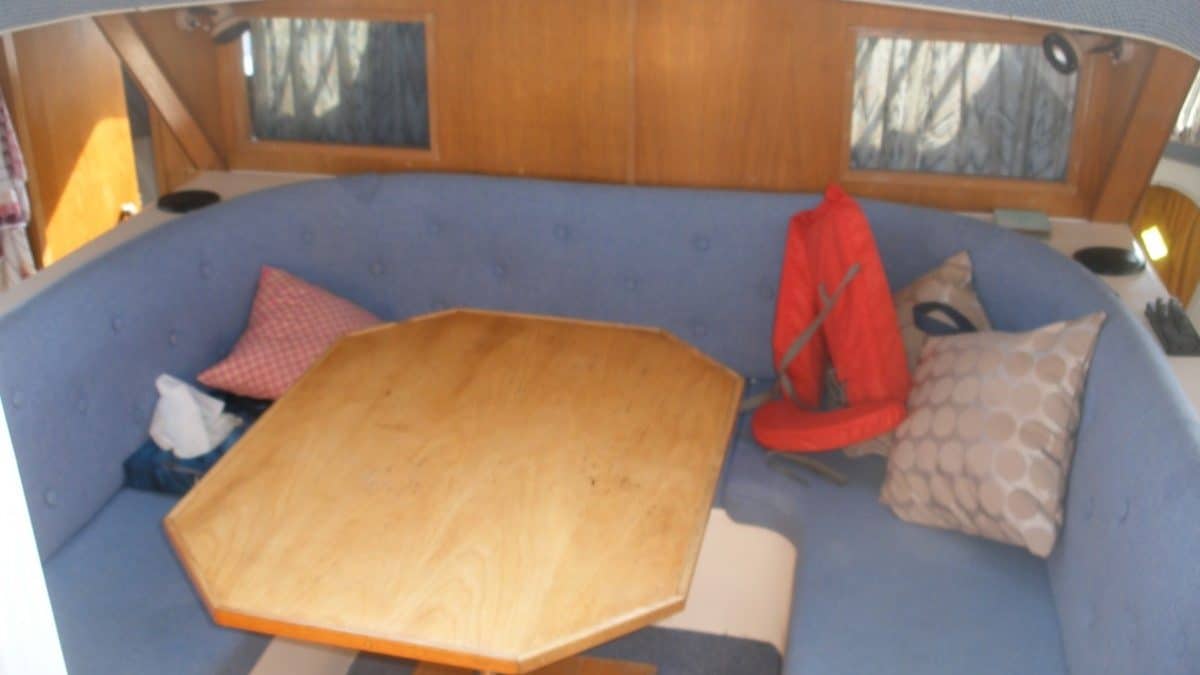
The Catalac’s structure features solid fiberglass, chined hulls, and a staggered sheerline that allows easy aft access. With a modest rig that’s easy to handle, the Catalac can deliver top speeds of up to 12-14 knots (13.81-16.11 mph / 22.22-25.9 kph) under sail.
Given that the boat’s design focuses more on comfort than speed, this is a spectacular performance.
Catalac 9M requires a skilled hand when turning into the wind as it is prone to blowing sideways. This is because the boat lacks ballast (which helps in keeping momentum during a tack) but also centerboards ( explained here ).
Skills are always the most essential things to bring aboard and you can acquire them in many ways, my two favorite ways are through NauticEd courses (two free courses here ) or by reading books (my top 15 books here )
Back to the boat! This model came in two versions; the standard layout contained a 30-40hp outboard, while the second option had duo engines. The latter is easier to maneuver into a marina.
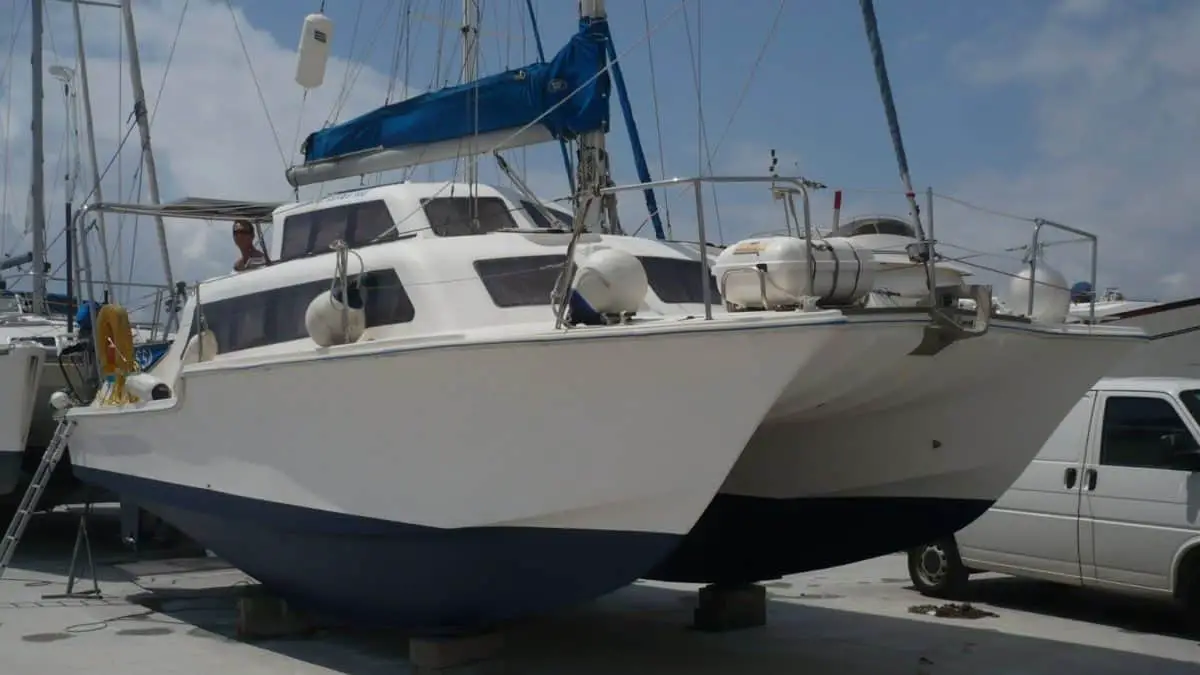
These cats retain their value pretty well. However, they might not be easy to come by since most owners find it challenging to get their hands on a larger boat with similar qualities and performance.
A Catalac 30 (9M) goes for between $33,000 and $55,000.
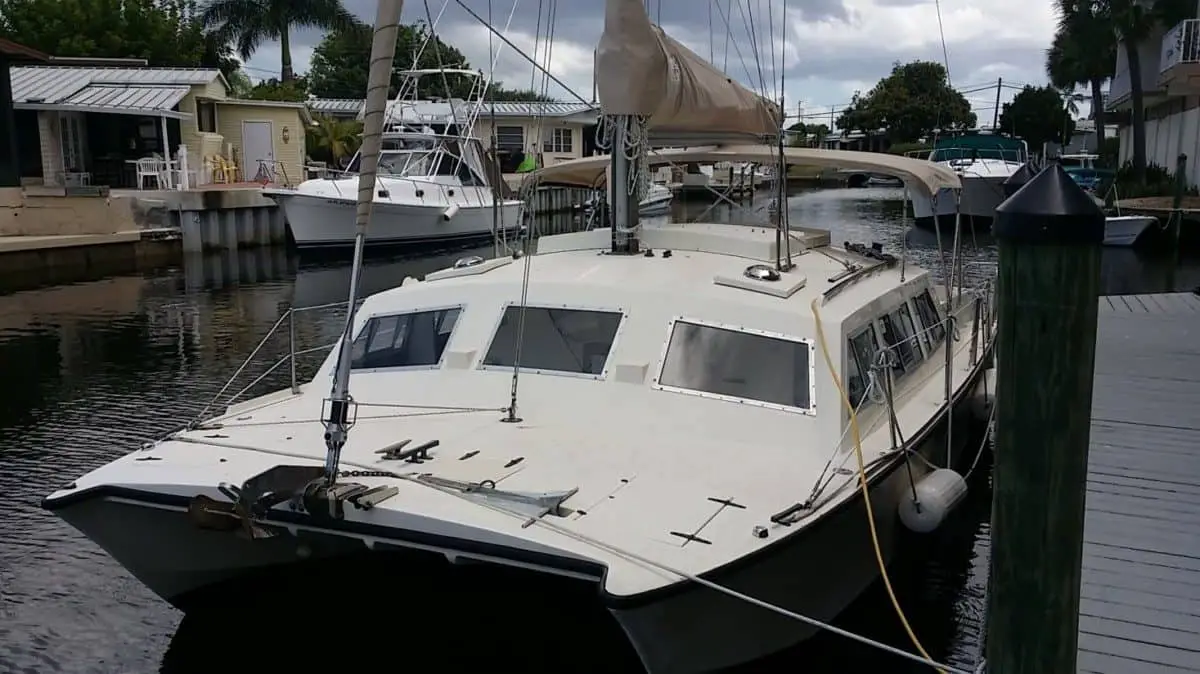
Catalac 27 (8M)
The Catalac 27 8M is a pocket cruiser that boasts a strong reputation for high quality, durability, and strength. Besides, the boat’s design makes it somewhat suitable for bluewater sailing ( understand why the small size is an offshore problem).
Built like a battleship, the boat contains solid fiberglass hulls. Additionally, it comes with double engines, a large cockpit fitted with cushions all around, and features standing headroom in each hull.
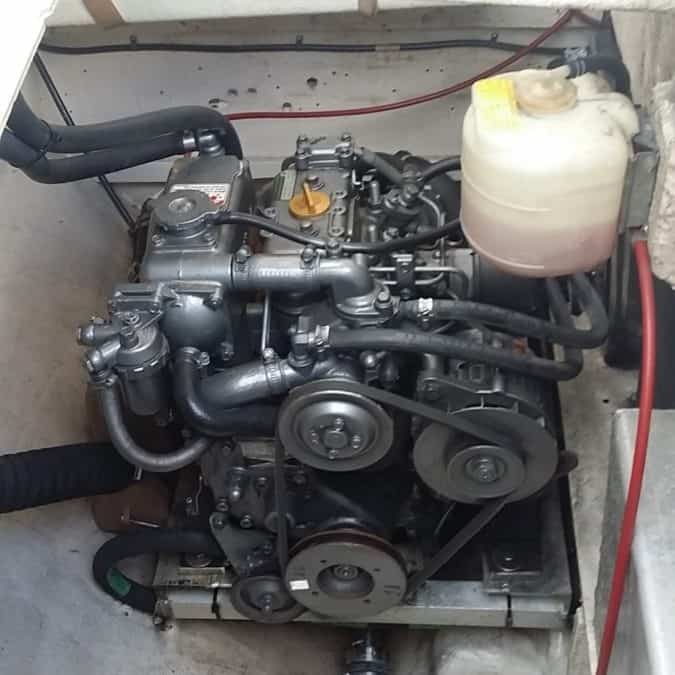
Like the Catalac 9M, this boat comes with two different layouts; a twin inboard diesel engine or an outboard engine. The twin-engine models can motor up to 1000 km (621 miles, read more on cat fuel consumption here ) without needing to refuel, while the 70 amps of charge plus water tanks (70 gallons / 265 liters) make these vessels remarkable coastal cruisers.
Catalacs equipped with outboard engines sail faster since you can raise the engine during sailing and are also lighter. This helps to minimize drag . Catalac 8M sports a short but thick mast that helps make the boat stable.
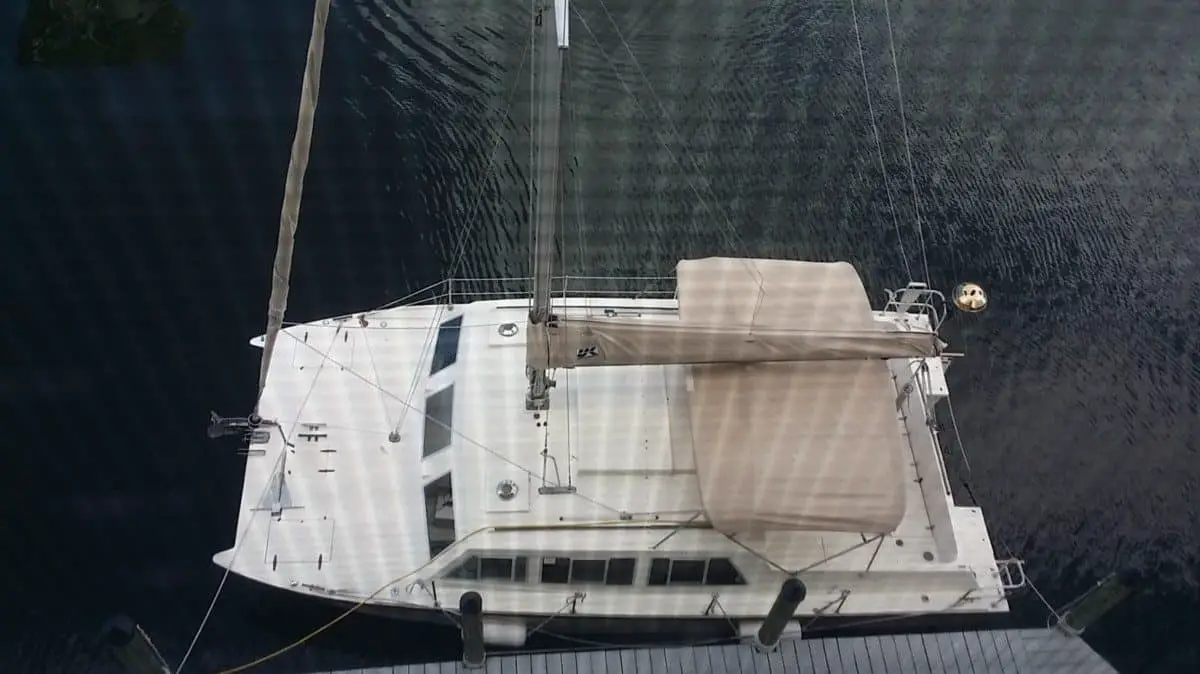
Though small in size, this catamaran packs a lot of features in its small frame. It has a full-sized berth, a large galley that’s almost 8 feet (2.4 m) long, a quarter berth, head, and navigation station.
What’s more, the cockpit is as large as that of a 38 to 40-foot (11.5 to 12.1 m) cat.
Catalac 27 costs about $31,836.
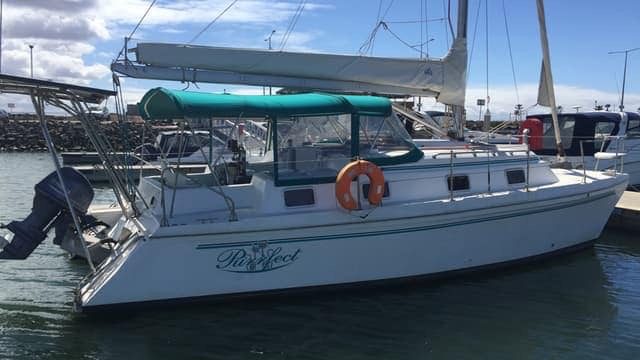
The Endeavour 30
The Endeavour 30 catamaran is a boat characterized by stability, ample deck space, and a spacious interior. It boasts fast cruising speeds under both sail and power.
The boat has mini keels and rudders plus symmetrical hulls separated by a hydra-cell. The latter is a center section with a characteristic V-shape.
The boat’s vacuum-bagged construction helps enhance strength and stiffness while reducing weight. Furthermore, the interior has a fiberglass mold, providing extra strength and rigidity. With sufficient breeze, this vessel can deliver reasonable off-the-wind and doable upwind speeds.
As such, you can expect to attain speeds of about ~10 knots (11.51 mph or 18.5 kph) on power reaches. Below is a video showing a panoramic tour of the Endeavour 30:
This vessel has the internal capacity of a 40-foot (12.1 m) monohull. And you can tell this from the unique layout merging the cabin and cockpit with wide doors to the numerous features packed into this 30-foot (9.14 m) vessel.
It has a spacious salon, an enormous galley, two queen berth staterooms with plenty of storage space, a head with separate showers, and a sizable U-shaped dinette.
You can get this boat for under $50,000 .
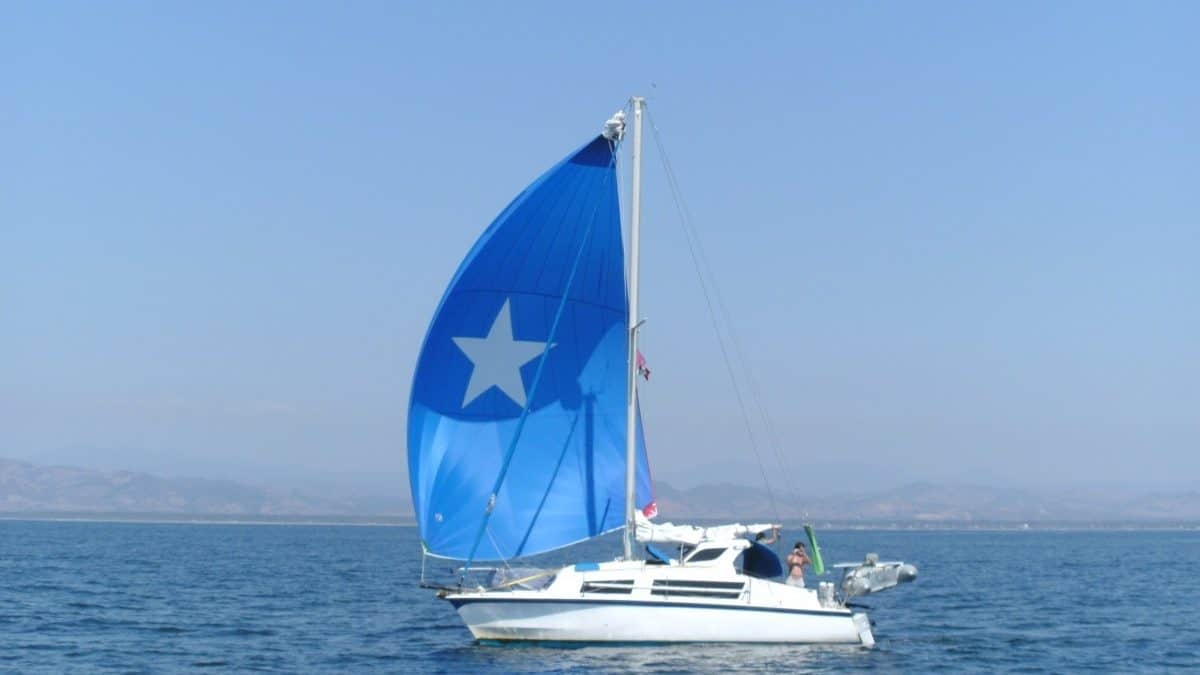
The Geminis by Tony Smith were the United States’s first production cruising cats. Today, these vessels remain the most appealing American-built cruising catamarans. Built between 1981 and 1990, the Gemini 30 does not have a contemporary design, but it works remarkably well for cruisers desiring generous living space in a small affordable sailboat.
At only 14 feet (4.2 m) across, Gemini cats are somewhat narrow. But this mean s they can easily fit into most of the regular marina berths.
Besides, the boats still contain enough interior space for a queen-size double berth and two smaller doubles housed in separate guest rooms.
There’s also a modest but serviceable saloon with duo settees and a collapsible table that can transform into an additional double berth.
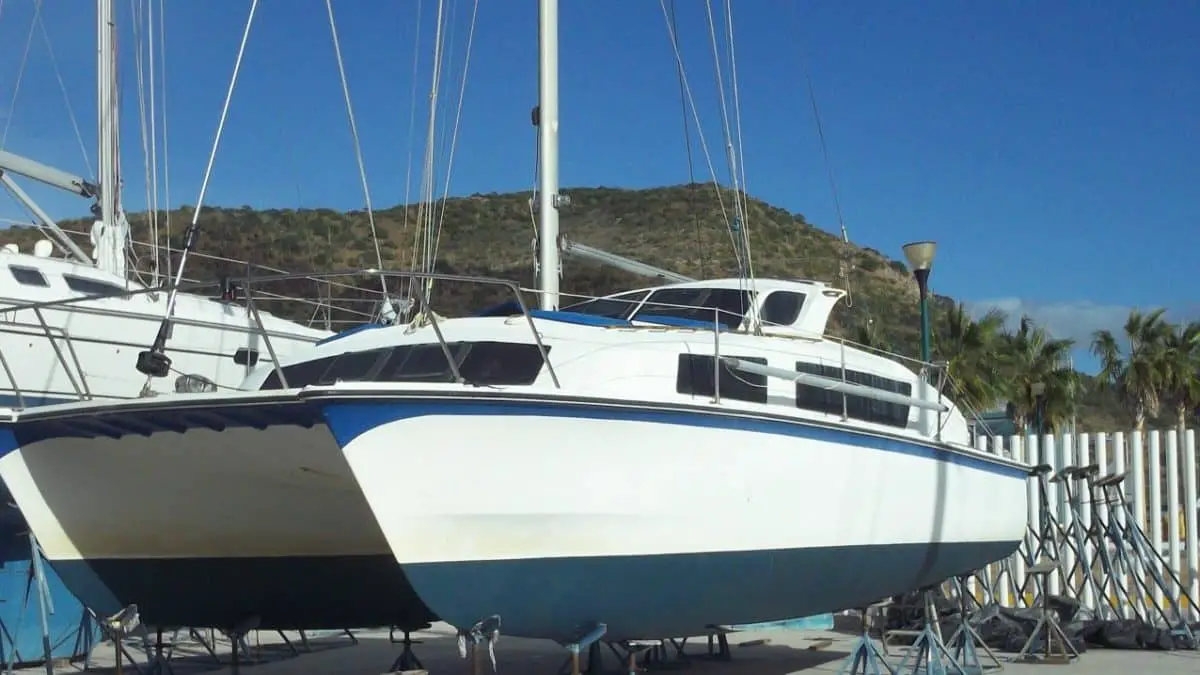
For the Gemini 30, this translates to a cruising cat with standing headroom that can comfortably accommodate 3 couples in private cabins or a family with small children. A good-sized galley, a spacious head with a shower, nav desk, and a large comfy cockpit make up the Gemini 30’s cruising palace.
Catamaran layout is highly personal and if you want to learn more about different characteristics then I suggest you read my article Designing the perfect catamaran layout ( Link )
While not that fast, the Gemini 30 will easily outsail the Endeavor 30 discussed above. Its daggerboards (which are explained in detail here ) can point well, and if you keep it light, it can do 7-8 knots (12.9-14.8 km/hr) under sail.
Besides, raising the daggerboards reduces the wetted surface area, and increases the speed downwind.
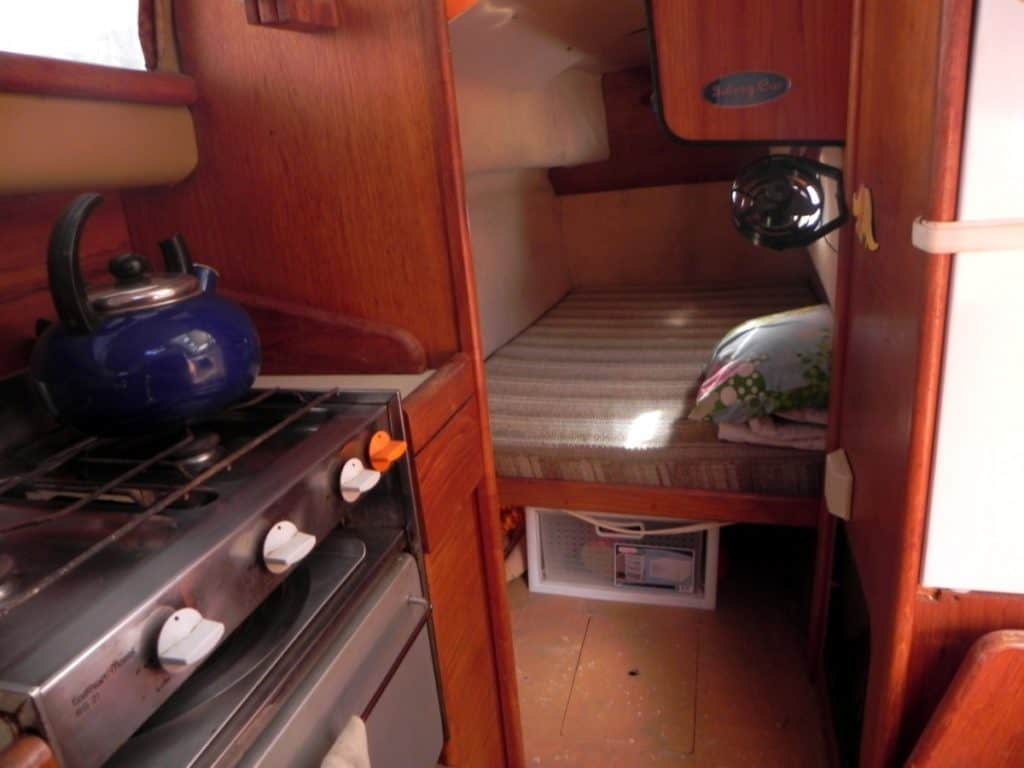
The Gemini 30 tends to pound and hobbyhorse a little when sailing in choppy waters – particularly when overloaded (more on load carrying capabilities in this article ), but the deep pivoting daggerboards provide stability and lift underwater.
Furthermore, the Gemini’s retractable rudders enable it to venture into shallow waters.
This is a very popular cruising cat that’ll give you a lot of bang for your bucks.
You can find a Gemini for less than $65,000.

Maine Cat 30
The Maine Cat 30 combines premium quality construction materials with the most advanced building techniques to create a lightweight vessel capable of handling most offshore conditions. What’s more, this boat can remain trouble-free for years on end with little effort.
If you are in the market for a simple liveaboard cruiser that you can use for a short weekend getaway or a cruising voyage, this is it.
The boat has a sizable primary stateroom berth with ample overhead space and a dresser fitted with a hanging storage cabinet. The enormous head includes a toilet, sink, 20-gallon (75.71 L) holding tank, vanity, and a pressurized shower.
Covering the open bridgedeck is a permanent hardtop. This spacious bridgedeck can hold quite a crowd and comes with a convertible dinette that turns into an extra berth. If need be, you can even enclose the entire space using acrylic windows or screens. Gabo

The 360-degree visibility from the cockpit allows the captain plus the crew a panoramic view, and all sail controls go back to the cockpit, which is very useful if wanting to sail single-handedly.
I believe that most boats should be set up in this way since sooner or later you might be in a situation where there is only one person to handle the controls, such as in an emergency. But more on that in another article ( Link ).
The Maine Cat 30 is a classic boat that delivers on high-performance multihull sailing. Designed to offer much better performance than catamarans bearing tall and heavy bridge decks, this cat weighs less and suffers less windage thanks to the acrylic windows.
The boat’s interior layout allows for easy cleaning as surfaces sport a smooth gel coat and satin-finished cherry trim. The solid but lightweight furniture bears the same Core-Cell foam core employed on the hull, deck, and hardtop. Plus, there’s ample storage for all your sailing equipment, cleaning supplies, and provisions.
A Maine Cat 30 can cost up to $110,000.
Heavenly Twins 27
The overall design of this well-equipped catamaran makes it a superb pocket cruiser.
Heavenly Twins 27 manages to fit not one but two coachroofs on hulls that are only 27 feet (8.20 m) long. Canoe sterns and a central cockpit separating the duo coachroofs form the boat’s other prominent features.
Famous for their excellent build quality, medium-depth draft, and narrow beams, Heavenly Twins 27 appeals to a wide range of boating enthusiasts.
These include solo sailors, weekend sailors, cruising families, circumnavigators, beginner sailors, and experienced liveaboards such as this famous Youtube channel “Kittiwake”.
The vessels house double cabins in the hulls while the forward starboard contains the heads and, to port, the galley. You can easily access the bar from the well-protected cockpit while the Comfordesk accommodation converts into a double dock.
A stoop through allows access from below-deck to the aft compartment without going through the cockpit. There’s ample storage space throughout the boat, plus you can section off the large stateroom into smaller double compartments if desired.
The price range for this boat is $ 20,098 to $24,193. (I believe that kittiwake is for sale too)
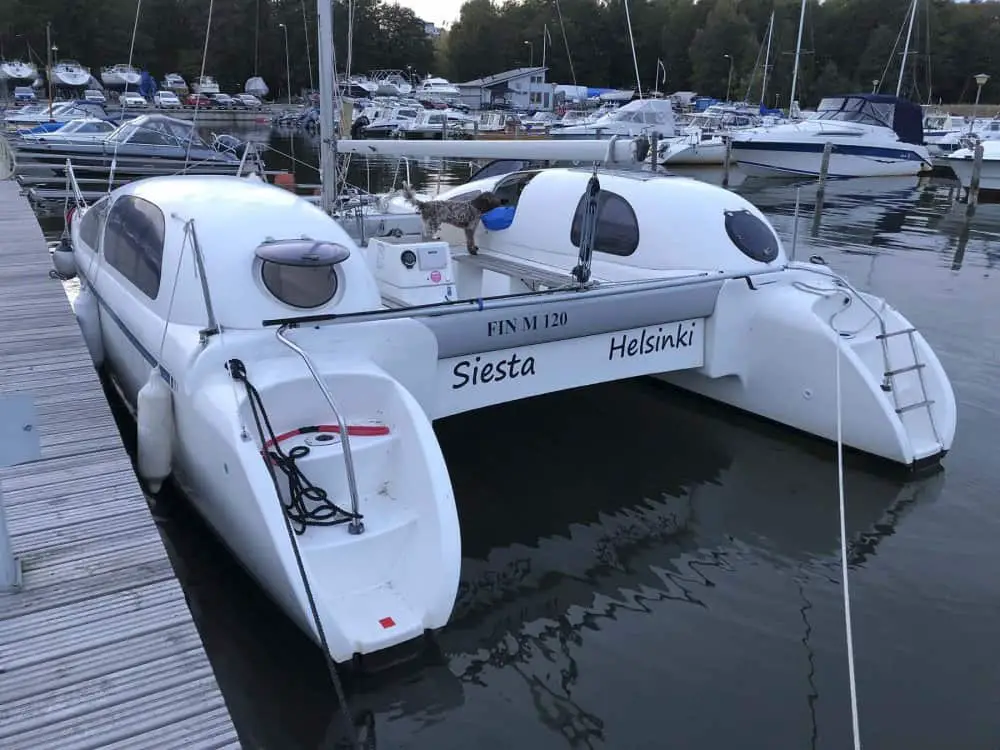
The last cruising catamaran on my list is the Aquilon 26 . This French-built cruising vessel is light in weight and trailerable, which means you can disassemble it in a few hours or transport it as-is.
Designing a boat that is possible to disassemble usually means that it is structurally less strong, which by no means is a problem during coastal sailing but the Aquilon 26 is mostly attractive to sailors who prefer inland lake sailing. It’s also suitable for beginner sailors.
Although there are no real “beginner cats” there are specs to consider if you are a beginner with catamarans, most of them I have listed in another article ( here ). Gabo
This 26-footer (7.92 m) has the potential for good speed though its layout is anything but conventional- which forms part of its appeal.
The cockpit works as the saloon, and a full bimini protects the crew from lousy weather. The starboard hull contains a dinette and galley, and the port has a double berth stateroom. The windows are quite unusual, but they provide lots of light, remarkably enhancing interior visibility.
Aquilon 26 can deliver an average cruising speed of 10knots (11.51 mph or 18.5 kph).
On a beam reach, you can expect around 25 knots (28.77 mph or 46.3 kph) with an adequate breeze ( I have never sailed at 25knots but researching this boat supposedly it is possible).
You can get this boat for under $50,000.
What Makes Small Cruising Cats Attractive?
Small cruising cats are ideal for sailing along the coast. But that’s not all. Under capable hands, properly fitted smaller cats can also deliver spectacular offshore passages similar to their larger counterpart (Heres a list of full-sized bluewater cats).
They can operate over long cruise ranges, cross oceans , and circumnavigate the globe . Smaller cats are also suitable for day sailing, overnight trips, and coastal or inland voyages.
For most sailors, comfort on board is crucial, so they’ll look for a vessel that guarantees a comfortable cruising experience. The good thing is that smaller vessels provide almost the same qualities and amenities that bigger vessels offer. Plus, you can do quite a bit with the available space, especially if it’s well laid out.
You’ll find that most 30-footer (9.14 m) or more miniature cruising cats comprise a galley, head, bunks, navigation and entertainment electronics, and refrigeration.
Sailors usually talk about these benefits of smaller cats:
- They’re less expensive. Large boats are costly to buy. They also cost more to hire, maintain, and dock. You can buy a small-sized boat at a much lower price, and parts tend to cost less too. Besides, you get to use smaller sails, winches, and lighter lines than those applicable on a larger boat. And since marine services such as moorings and haul-outs get billed via boat length, a smaller cat makes sailing more affordable.
- They boast superior builds. Most cruising boats under 30 feet (9.14 m) feature designs that are 30+ years old. In those days, weather forecasts were hard to come by and not as accurate, so boat builders used hulls with thicker fiberglass than the type found in today’s builds. Furthermore, everything in the boat, including rigs, rudders, hulls, keels and decks, was designed to withstand strong winds and high waves.
- They have simpler systems. This means less time spent fixing and maintaining your boat. For instance, most small cruising cats often lack water-makers, hot water systems, or electric anchor windlasses.
- They’re easier to handle. Smaller cats are simpler to sail than larger cats. It’s also easier to sail one single-handed or with a small crew.
What is the largest cat on person can sail?
The Disadvantages of Smaller Cruising Cats
Below are some of the most discussed downsides of small cats:
- They have limited living space, storage, and amenities.
- Though they don’t heel much, they are less comfortable than larger boats since they get tossed around much more easily in big ocean swells.
- It’s not easy to accommodate crew for extended periods; hence there are fewer hands to share work.
- They are slower and take longer to get to their destination.
Though fewer are on the cruising trails than their larger counterparts, small catamarans make ideal cruisers because they are simple, seaworthy, and pocket-friendly.
When choosing the best cat for your needs, focus on quality rather than size. A well-planned 30-footer (9.14 m) is reliable and provides ample space for your accommodation, dining, and relaxation, plus a storage room for provisions and any spare parts you might need.
And if you want even more info than I have presented to you in this article I would recommend a book from Serj, he makes it easy to understand why size matters and how to find a cat suited for your needs (amazon link )
Owner of CatamaranFreedom.com. A minimalist that has lived in a caravan in Sweden, 35ft Monohull in the Bahamas, and right now in his self-built Van. He just started the next adventure, to circumnavigate the world on a Catamaran!
Leave a Reply Cancel reply
Your email address will not be published. Required fields are marked *
Save my name and email in this browser for the next time I comment.
Recent Posts
Must-Have Boat Gear for Catamaran Sailors!
Sailing is probably the most gear-intensive activity I've ever done; there are so many decisions to be made about what gear to buy now, for tomorrow, and what to definitely never buy. The gear on...
6 Best Trailerable Trimarans For Bluewater and Coastal Sailing
Having a boat costs a lot of money, even when you are not using it, marina fees, etc. And once it is in the water most sailors never go very far from their "home marina" and sailing will be somewhat...
Maxi-Open Mangusta Yachts presented at Boat Shows in Palm Beach and Moscow
- Inspiration
Related News
Popular news this week, popular news this month, latest news.
- Yacht Charter & Superyacht News >
Written by Zuzana Bednarova
Two important events saw the Mangusta Maxi Open by the prominent Italian builder Overmarine again protagonist on the nautical scene: Marine Max exclusive partner for the United States attended the Palm Beach Boat Show , running from March 22 to 25 with the spectacular motor yacht Mangusta 92 and the Mangusta 130 superyacht on display. Burevestnik Group, on the other hand, was the star of the Moscow International Boat Show , taking place from March 20 to 25 exhibiting the scale models of the luxury yacht Mangusta Oceano 148, the superyacht Mangusta 92, the Mangusta 165 as well as Mangusta 130 yachts.
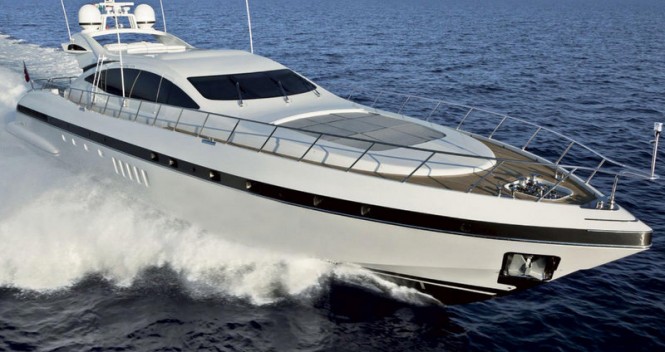
Mangusta 92 Superyacht
MANGUSTA 92 ( an example of Mangusta 92 is the motor yacht ILLUSION ) Stylish and fast luxury motor yacht Mangusta 92 represents perfect proportions. She offers an ambitious layout that permits for 3 beautiful staterooms and a relax room or 4 staterooms, each with high-tech entertainment centers. Run by twin MTU 16V2000M94 of 2600Hp each and Kamewa 56S3 jet drives, the Mangusta 92 achieves the exciting speed of 37 knots.
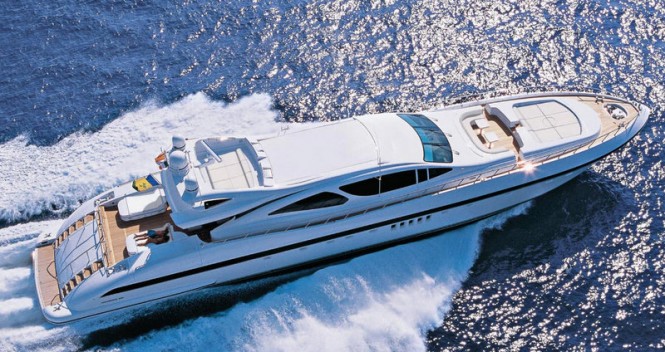
Luxury motor yacht Mangusta 130
MANGUSTA 130 ( for example the charter yacht Ability ) Mangusta 130 superyacht combines pleasure and performance. Her lower deck provides 4 lovely staterooms and a salon or 5 staterooms. When the twin 3640-hp MTU16V4000 M93L are fired up and bring the vessel to a full speed of 39 knots, the peaceful as well as relaxing feeling remains, as there is no noise or vibration.

Megayacht Mangusta 165
MANGUSTA 165 ( an example can be the luxury charter yacht ZEUS ) The biggest fiberglass Open Yacht ever built, the luxury megayacht Mangusta 165 brings together state of the art technology with extreme comfort. With a speed of 39 knots, the Mangusta 165 exceeds all expectations in terms of performance, with the stabilizers that provide the smoothest ride. This majestic and elegant vessel offers extraordinarily spacious interiors with four or five staterooms and a living space.
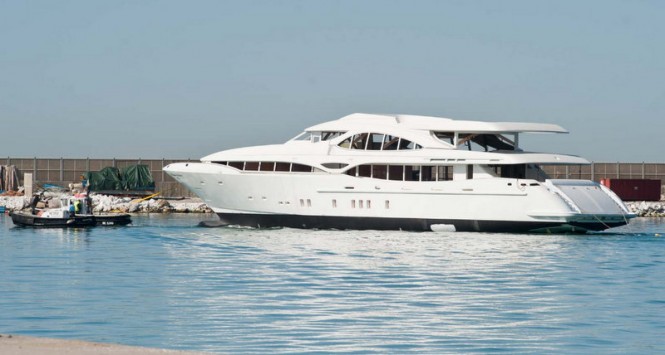
Superyacht Mangusta Oceano 148
MANGUSTA OCEANO 148 Mangusta Oceano 148 superyacht is built to provide her Owner with the utmost in luxury and comfort aboard by integrating the latest technology processes with the most advanced marine equipment available in the market. Her interiors can be built in any kind of wood and with the style (design) selected by the Owner.
Please contact CharterWorld - the luxury yacht charter specialist - for more on superyacht news item "Maxi-Open Mangusta Yachts presented at Boat Shows in Palm Beach and Moscow".
- Charity & Fund Raising
- CharterWorld News
- Classic Yachts
- Coronavirus
- Cruise Ship
- Ecological Yachts
- Expedition Yachts
- Expert Broker Advice
- Feature Superyachts
- Interior Design
- Legal & VAT Yacht Issues
- Luxury Catamarans
- Luxury Gulet
- Luxury Phinisi
- Luxury Trimarans
- Luxury Yacht Design
- Luxury Yachts
- Marinas & Harbours
- Marine Ecology
- Marine Electronics
- Marine Equipment
- Mega Yachts
- Modern Yachts
- Motor Yachts
- New Launch Yachts
- New To Charter
- Open Style Sports Yachts
- Private Jets
- Sailing Yachts
- Social Media
- Sports Yachts
- Superyacht Crew
- Superyacht Photographers
- Superyacht Products & Supplies
- Superyacht Refits
- Superyacht Reviews
- Superyachts
- Uncategorized
- Yacht Builders
- Yacht Charter
- Yacht Charter Destinations
- Yacht Charter Picks
- Yacht Charter Specials
- Yacht Delivered to Owner
- Yacht Designers
- Yacht Events & Boat Shows
- Yacht Fashion
- Yacht Industry News
- Yacht Photos
- Yacht Racing
- Yacht Racing & Regattas
- Yacht Safety Equipment
- Yacht Support Vessels
- Yacht Tenders
- Yacht Videos
- Yachting Associations
- Yachting Awards
- Yachting Business
- Yachts For Charter
- Yachts For Sale
Quick Enquiry
Superyacht news:.
Email Your Yachting News to: news @ charterworld.com
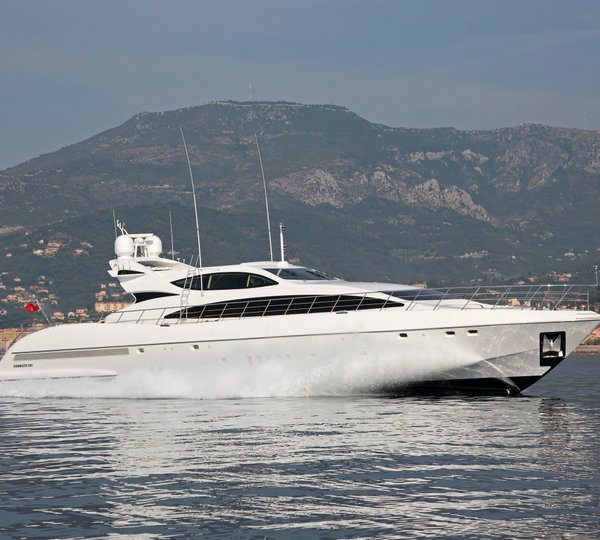
50M OPEN-STYLE SPORTS YACHT
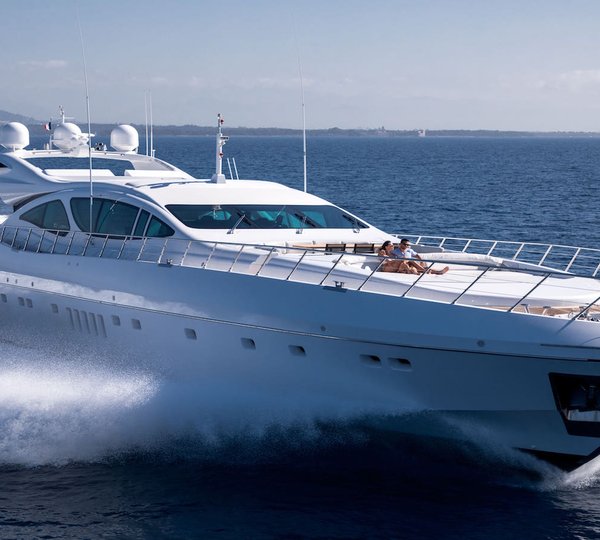
Luxury Yachts At Events
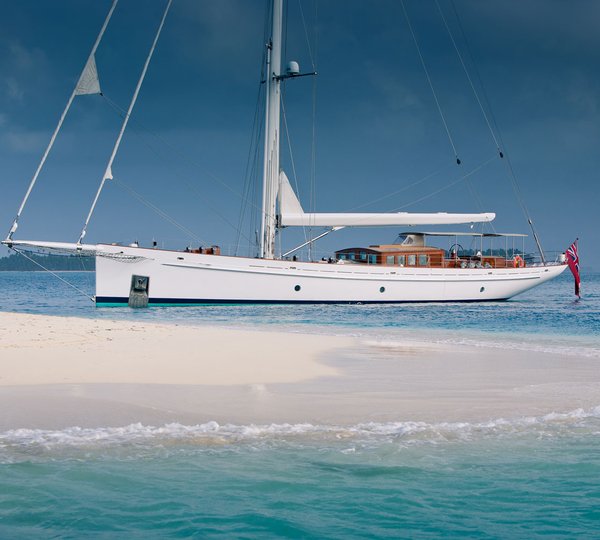
The Caribbean
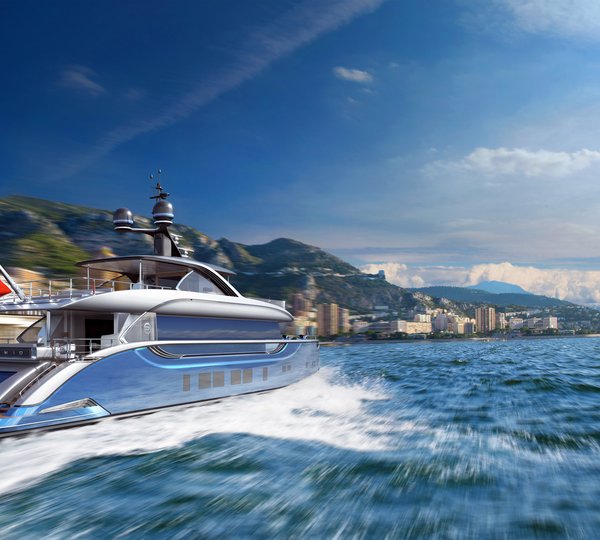
The Mediterranean
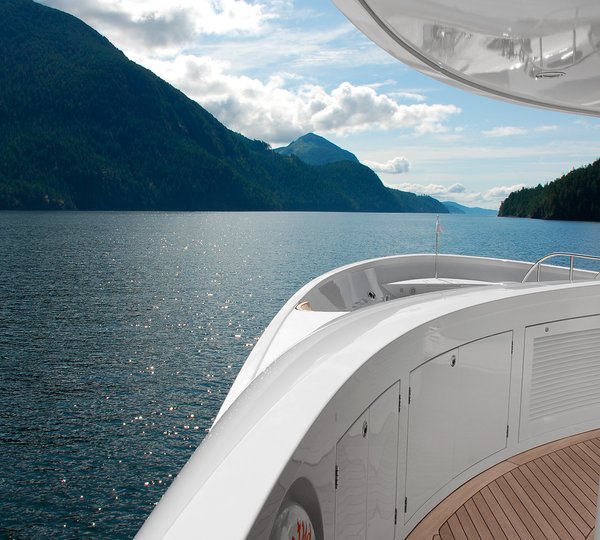
The Pacific Northwest
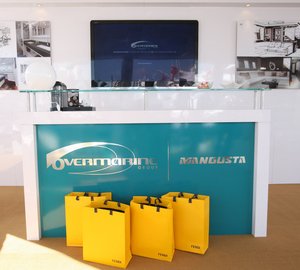
Successful cooperation between Overmarine Group | Mangusta and Luxury Living – FENDI Casa at FLIBS
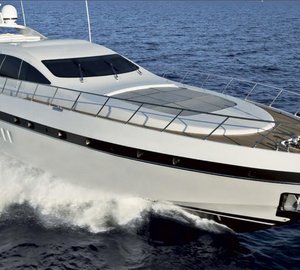
Overmarine Group at Dusseldorf Boat Show with Mangusta 92, Mangusta 130, Mangusta 165 and Mangusta 148 Oceano Yachts on display
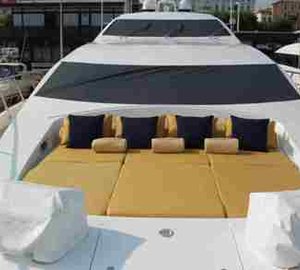
Eye-catching Mangusta 130 Motor Yacht HAPPY DAY spotted in Fort Lauderdale

Video introducing new Mangusta 165 E superyacht MOONRAKER
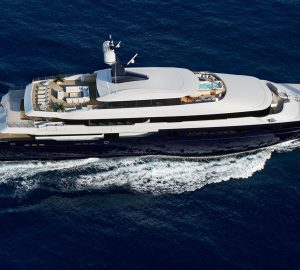
Late summer special offer on board 72m superyacht ARBEMA in the Western Mediterranean
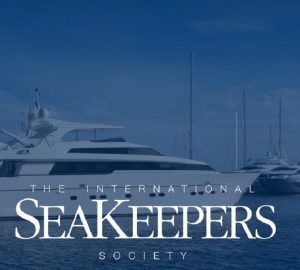
The International SeaKeepers Society will host its 2024 annual Founders Event in October

Special offer for remaining weeks of September on board 51m sailing yacht RED DRAGON
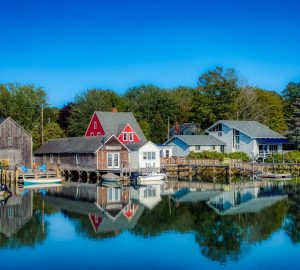
A luxury charter yacht is the perfect way to encounter New England’s fall foliage display

Navigating the World of Luxury Yacht Charters: Your Guide to the Perfect Getaway

OCEA delivers 33m motor yacht ARAOK II to her new owner
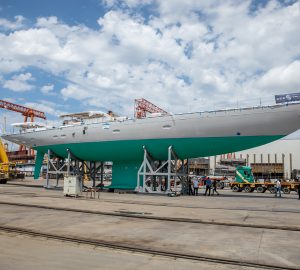
39m sailing yacht LINNEA AURORA launched by SES Yachts
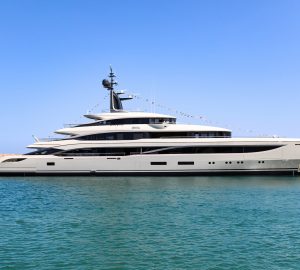
66m Benetti motor yacht IRYNA hits water in Italy

A first look at 55m superyacht PROJECT AGNETHA from Heesen Yachts
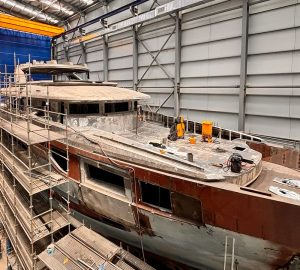
44m superyacht ORION ONE reaches a construction milestone
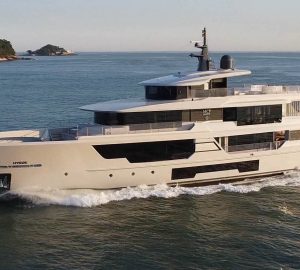
40m superyacht HYGGE from MCP Yachts commences sea trials
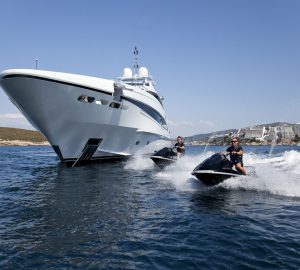
44m charter yacht JEMS offers 9 days for the price of 7 in August in Italy
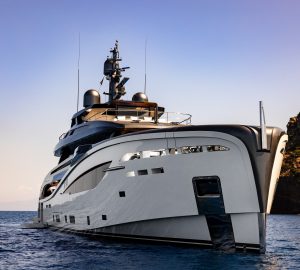
Rossinavi introduces full custom 50m superyacht BEL1
- News & Reviews
We’re Showcasing Two Models at Cannes Yachting Festival 2024
August, 2024, Cannes, France- Balance Catamarans will display two of its models at the prestigious Cannes Yachting Festival. This is the first time the Balance 526 and the Balance 442 will be on display for the Festival audience.
Dates: September 10 – 15 Featured Catamarans: Balance 526 & Balance 442

Balance 526 – PIPPILOTTA
The Balance 526 is a highly regarded high-performance cruising vessel that is celebrated for its innovative design, lightweight construction, and racing pedigree. A Balance 526, christened Norhi, recently was first to finish and overall winner of the Cape2Rio Race. The 526 exemplifies speed, agility, and superior engineering. Designed for serious sailors who seek a perfect blend of comfort and performance, this model offers a spacious interior with a sleek, contemporary aesthetic, and an optimized sail plan for fast and efficient cruising. The yacht’s performance is matched by its luxurious amenities, ensuring a top-tier experience whether at anchor or underway.

Watch Pippilotta in action: Sailing in Cape Town
To schedule a private tour or for more information, please contact [email protected] .

Balance 442 – LASAI
The Balance 442 is a versatile and dynamic addition to the Balance Catamarans fleet of five model lines. The 442 is the smallest catamaran in the Balance range and provides an accessible yet highly capable platform for those embarking on long voyages. This model features a thoughtful layout that maximizes space and comfort, offering flexible accommodation options that cater to both family cruising and adventurous expeditions. The Balance 442’s robust construction and advanced sailing capabilities make it an ideal choice for sailors looking for a reliable, easy-to-handle catamaran that doesn’t compromise on performance.
Follow Lasai’s Owners John & Jayden, aka the TipsyNomads, as they explore the mediterranean. Their Instagram here and on Youtube here .

Take a tour of Lasai right now: 360 Walkthrough
Both models reflect the core design and sailing philosophy of Balance Catamarans: create yachts that are not only aesthetically pleasing but also built to deliver unparalleled performance on the water. The company’s commitment to innovation, quality craftsmanship, and customer satisfaction is evident in every detail of these yachts.
Visitors to the Cannes Yachting Festival are invited to explore these remarkable catamarans and discover the unique features that set Balance Catamarans apart in the competitive world of luxury sailing. Balance founder and president, Phillip Berman, will also be at the Festival to discuss the entire line of Balance models including the 442,482,526, 580, and 750.
We look forward to welcoming you aboard and sharing our passion for sailing with you. See you at the shows!
Related Content
Come one, come all to the international boat show la grande motte 2023, tick tock...cannes boat show, experience balance catamarans at premier 2024 boat shows.
Ainslie set to begin bid for America's Cup glory
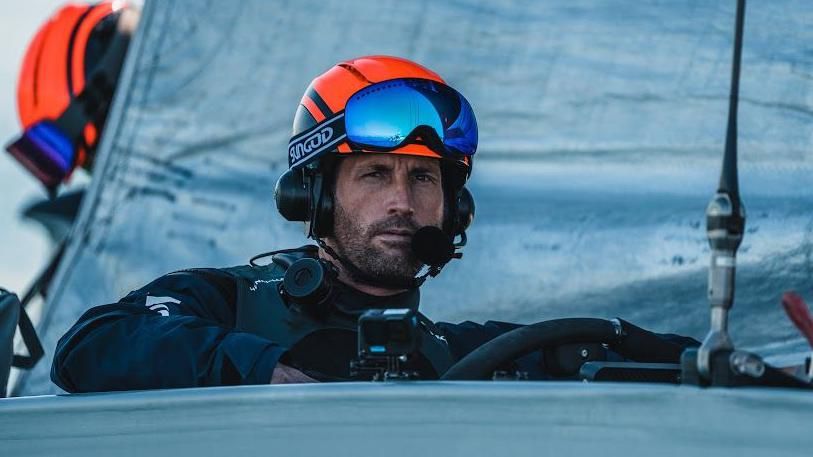
Ben Ainslie is at helm of the British America's Cup contender for the third time
- Published 21 August 2024
Ben Ainslie's Ineos Britannia team are set to start their bid to become the first British crew to win the America's Cup.
After almost three years of meticulous planning and testing, six teams will race their new AC75 boats against each other for the first time on Thursday in the final preliminary regatta.
The four-day event takes place within sight of the port area of Barcelona, the host city for the 37th America's Cup. , external
The competition begins in earnest on 29 August, with a series of races to decide which boat will take on defending champions New Zealand for the trophy in October.
Four-time Olympic sailing champion Ainslie is the skipper and chief executive officer of the Britannia team, , external which is backed by billionaire Sir Jim Ratcliffe's Ineos Group.
They have worked with the Mercedes Formula 1 team to develop their boat, and with the Ineos Grenadiers cycling team to help the crew reach their physical peak.
First held around the Isle of Wight in 1851, the America's Cup is the world's oldest sporting event.
Here is our guide to the 37th edition, which includes a women's series for the first time in the competition's 173-year history.
How does the America's Cup work and what's the schedule?
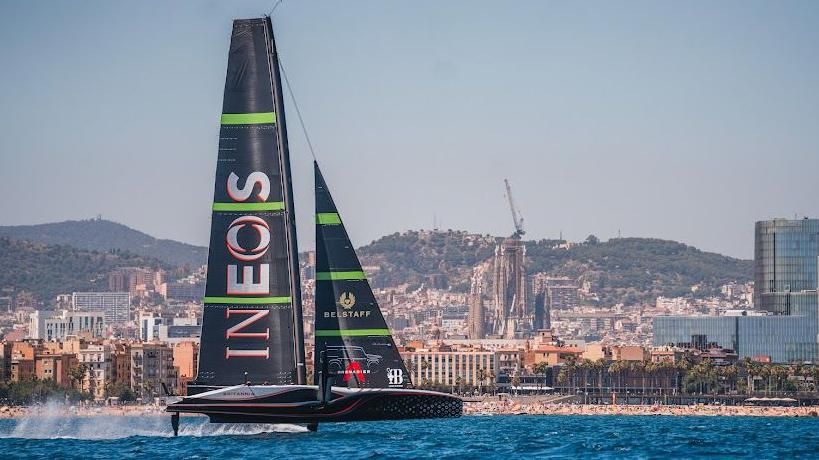
Ineos Britannia skimming over the water off the coast of Barcelona
Team New Zealand automatically qualify for the America's Cup final match having won the trophy - known as the Auld Mug - in 2021.
The British team will take on rivals from Switzerland (Alinghi Red Bull Racing), Italy (Luna Rossa), the United States (NYYC American Magic) and France (Orient Express Racing Team) in the Challenger Selection Series leading up to the final series.
Known as the Louis Vuitton Cup, there are three competitions from 29 August to 7 October:
29 August to 8 September: Louis Vuitton Cup round-robin stage - all teams race each other twice, with the top four going through and the leading team choosing who they face in the semi-finals
14-19 September: Louis Vuitton Cup semi-finals - first to win five races advances
26 September to 7 October: Louis Vuitton Cup final - first to win seven races qualifies for the America's Cup match
12-17 October: the 37th America's Cup - the Louis Vuitton Cup winner takes on holders Team New Zealand, with the first to seven race victories winning the trophy
• Races start at 13:00 BST and reserve dates are scheduled if required. You can watch the action live on TNT Sports.
How fast are the America's Cup boats?
Ineos Britannia have enlisted the help of engineering experts at the Mercedes Formula 1 team in Brackley, Northamptonshire in a bid to find a technical advantage over their rivals.
The AC75, or America's Cup 75, is a 75ft foiling race boat with one carbon-fibre hull (a monohull instead of catamaran or trimaran) and has been described as like a "large windsurfing board with towering sails" by Sailing World. , external
The AC75s - which have sails up to 26.5m high - have extendable hydrofoil wings which can lift the hull up and enable the boats to skim the surface of the water so they appear like they are flying.
This helps the boats to reach exhilarating speeds of more than 50 knots (57.5mph), despite weighing about 6.5 tonnes.
But make a mistake and the boats could capsize.
What is a cyclor and why are they key?

Britannia's crew features Olympic medallists and world champions from the sports of sailing and rowing
Fast starts are key, race tactics and weather conditions will all play their part, but it could be human effort which determines who wins the America's Cup.
Each boat has eight crew members, reduced from 11 last time, with two helmsmen and two sail trimmers on different sides.
Joining Ainslie as co-helm will be Olympic gold medallist Dylan Fletcher, who won the 49er class at Tokyo 2020, while Leigh McMillan and Bleddyn Mon are the trimmers.
The other four sailors on the boat provide the hydraulic power to trim the sails by pedalling static bikes fixed inside the hull.
Four of the nine "cycling sailors" in the Britannia squad have an Olympic rowing background - including 2016 gold medallist Matt Gotrel and Tokyo silver medallist Harry Leask.
Known as "cyclors", they have been put through their paces on dry land by Grenadiers’ top cyclists to build their endurance levels.
Double Olympic gold medallist Giles Scott is the team's head of sailing.
There is also a big onshore team including sailmakers, engineers, software technicians and even meteorologists.
It is estimated that the average America’s Cup campaign costs about £100m.
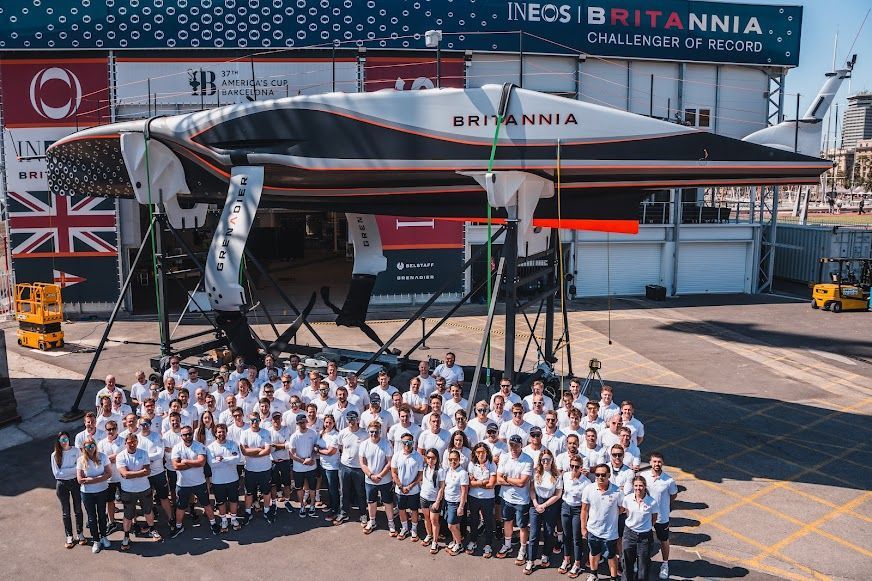
Ineos Britannia's performance, operation and support team in Barcelona with the AC75 boat Britannia
Ben Ainslie's mission to win the America's Cup
Ainslie won medals at five consecutive Olympics from 1996 onwards, including gold at four consecutive Games from 2000 to 2012.
Competing initially in the Laser category, he switched to the larger Finn boats and won nine World Championship titles across both classes.
Since winning gold at London 2012, Ainslie's goal has been to claim the America's Cup for Great Britain.
He set up his own British team to compete in the America's Cup World Series in 2012-2013 with the aim of gaining experience for a full challenge in 2017.
Ainslie went on to win the Auld Mug in 2013, using all his tactical nous to turn around Team Oracle USA's fortunes in spectacular style.
His two subsequent attempts in a British boat have ended in disappointment.
In 2017, Ainslie's Land Rover BAR team were knocked out in the semi-finals.
In the Covid-hit 2021 campaign, his Ineos Team UK won the round-robin stage but lost 7-1 to Luna Rossa in the final selection race series.
What about the Women's America's Cup?
Women have competed in the America's Cup before - most notably American Dawn Riley, who has sailed in the competition three times and was team manager of the French entry in 2007 - but have never had a standalone series.
The inaugural Women’s America’s Cup takes place in AC40 boats - a smaller version of the AC75 - from 5-13 October in Barcelona.
Great Britain's Athena Pathway will be one of 12 teams to start the qualification series from 5-9 October.
Hannah Mills, Britain's most successful female Olympic sailor - with two golds and a silver - leads the 12-strong British squad.
The 36-year-old from Wales has assembled a team full of Olympic and world medallists, including her former partner Saskia Clark and Paris 2024 kite sailing gold medallist Ellie Aldridge.
They will hope to advance to the final on 11 October, and from there reach the match race final on 13 October.
Great Britain are also represented in the Youth America’s Cup, taking place from 17-26 September.
Related Topics
Advertisement
Supported by
Lynch Yacht Sinking Off Sicily Proves as Baffling as It Is Tragic
As bodies were recovered, the authorities and experts wondered how a $40 million, stable and secure vessel could have sunk so quickly.
- Share full article

By Emma Bubola and Michael J. de la Merced
Emma Bubola reported from Porticello, Italy, and Michael J. de la Merced from London.
Two months after being cleared in a bruising legal battle over fraud charges, the British tech mogul Mike Lynch celebrated his freedom with a cruise. He invited his family, friends and part of his legal team on board his luxury sailing yacht, a majestic 180-foot vessel named Bayesian after the mathematical theorem around which he had built his empire.
On Sunday night, after a tour of the Gulf of Naples, including Capri, and volcanic islands in the Eolian archipelago, the boat anchored half a mile off the Sicilian coast in Porticello, Italy. It chose a stretch of water favored by the Phoenicians thousands of years ago for its protection from the mistral wind and, in more recent times, by the yachts of tech billionaires. The boat was lit “like a Christmas tree,” local residents said, standing out against the full moon.
But about 4 a.m., calamity unfolded. A violent and fast storm hit the area with some of the strongest winds locals said they had ever felt. Fabio Cefalù, a fisherman, said he saw a flare pierce the darkness shortly after 4.
Minutes later, the yacht was underwater. Only dozens of cushions from the boat’s deck and a gigantic radar from its mast floated on the surface of the sea, fishermen said.
In all, 22 people were on board, 15 of whom were rescued. Six bodies — five passengers and the ship’s cook — had been recovered by Thursday afternoon, including that of Mr. Lynch, an Italian government official said, adding that the search was continuing for his daughter.
It was a tragic and mystifying turn of events for Mr. Lynch, 59, who had spent years seeking to clear his name and was finally inaugurating a new chapter in his life. Experts wondered how a $40 million yacht, so robust and stable could have been sunk by a storm near a port within minutes.
“It drives me insane,” said Giovanni Costantino, the chief executive of the Italian Sea Group, which in 2022 bought the company, Perini, that made the Bayesian. “Following all the proper procedures, that boat is unsinkable.”
The aura of misfortune only deepened when it emerged that Stephen Chamberlain, 52, a former vice president of finance for Mr. Lynch’s former company and a co-defendant in the fraud case, was killed two days earlier, when he was hit by a car while jogging near his house in England.
Since June, the two men had been in a jubilant mood. A jury in San Francisco had acquitted both on fraud charges that could have sent them to prison for two decades. There were hugs and tears, and they and their legal teams went for a celebratory dinner party at a restaurant in the city, said Gary S. Lincenberg, a lawyer for Mr. Chamberlain.
The sea excursion was meant as a thank-you by Mr. Lynch to those who had helped him in his legal travails. Among the guests was Christopher J. Morvillo, 59, a scion of a prominent New York family of lawyers who had represented Mr. Lynch for 12 years. He and his wife, Neda, 57, were among the missing.
So, too, was Jonathan Bloomer, 70, a veteran British insurance executive who chaired Morgan Stanley International and the insurer Hiscox.
The body of the ship’s cook, Recaldo Thomas, was recovered. All the other crew members survived. Among them was Leo Eppel, 19, of South Africa, who was on his first yacht voyage working as a deck steward, said a friend, who asked not to be identified.
Since the sinking, the recovery effort and investigation have turned the tiny port town of Porticello, a quiet enclave where older men sit bare-chested on balconies, into what feels like the set of a movie.
Helicopters have flown overhead. Ambulances have sped by with the sirens blaring. The Coast Guard has patrolled the waters off shore, within sight of a cordoned-off dock that had been turned into an emergency headquarters.
On Wednesday afternoon, a church bell tolled after the first body bag was loaded into an ambulance, a crowd watching in silence.
The survivors were sheltering in a sprawling resort near Porticello, with a view of the shipwreck spot, and had so far declined to comment.
Attilio Di Diodato, director of the Italian Air Force’s Center for Aerospace Meteorology and Climatology, said that the yacht had most likely been hit by a fierce “down burst” — when air generated within a thunderstorm descends rapidly — or by a waterspout , similar to a tornado over water.
He added that his agency had put out rough-sea warnings the previous evening, alerting sailors about storms and strong winds. Locals said the winds “felt like an earthquake.”
Mr. Costantino, the boat executive, said the yacht had been specifically designed for having a tall mast — the second-tallest aluminum mast in the world. He said the Bayesian was an extremely safe and secure boat that could list even to 75 degrees without capsizing.
But he said that if some of the hatches on the side and in the stern, or some of the deck doors, had been open, the boat could have taken on water and sunk. Standard procedure in such storms, he said, is to switch on the engine, lift the anchor and turn the boat into the wind, lowering the keel for extra stability, closing doors and gathering the guests in the main hall inside the deck.

12 guests occupied the yacht’s six cabins. There were also 10 crew members.
Open hatches, doors and cabin windows could have let in water during a storm, according to the manufacturer.

Open hatches, doors and
cabin windows could
have let in water
during a storm,
according to the
manufacturer.
Source: Superyacht Times, YachtCharterFleet, MarineTraffic
By Veronica Penney
The New York Times attempted to reach the captain, James Cutfield, who had survived, for comment through social media, his brother and the management company of the yacht (which did not hire the crew), but did not make contact.
So far none of the surviving crew members have made a public statement about what happened that night.
Fabio Genco, the director of Palermo’s emergency services, who treated some of the survivors, said that the victims had recounted feeling as if the boat was being lifted, then suddenly dropped, with objects from the cabins falling on them.
The Italian Coast Guard said it had deployed a remotely operated vehicle that can prowl underwater for up to seven hours at a depth of more than 980 feet and record videos and images that they hoped would help them reconstruct the dynamics of the sinking. Such devices were used during the search and rescue operations of the Titan vessel that is believed to have imploded last summer near the wreckage of the Titanic.
After rescuers broke inside the yacht, they struggled to navigate the ropes and many pieces of furniture cluttering the vessel, said Luca Cari, a spokesman for Italy’s national firefighter corps.
Finally, as of Thursday morning, they had managed to retrieve all but one of the missing bodies, and hopes of finding the missing person alive were thin. “Can a human being be underwater for two days?” Mr. Cari asked.
What was certain was that Mr. Lynch’s death was yet another cruel twist of fate for a man who had spent years seeking to clear his name.
He earned a fortune in technology and was nicknamed Britain’s Bill Gates. But for more than a decade, he had been treated as anything but a respected tech leader.
He was accused by Hewlett-Packard, the American technological pioneer that had bought his software company, Autonomy, for $11 billion, of misleading it about his company’s worth. (Hewlett-Packard wrote down the value of the transaction by about $8.8 billion, and critics called it one of the worst deals of all time .) He had been increasingly shunned by the British establishment that he sought to break into after growing up working-class outside London.
He was extradited to San Francisco to face criminal charges, and confined to house arrest and 24-hour surveillance on his dime. In a townhouse in the Pacific Heights neighborhood — with security people he jokingly told associates were his “roommates” — he spent his mornings talking with researchers whom he funded personally on new applications for artificial intelligence. Afterward, he devoted hours to discussing legal strategy with his team.
Despite his persistent claims of innocence, even those close to Mr. Lynch had believed his odds of victory were slim. Autonomy’s chief financial officer, Sushovan Hussain, was convicted in 2018 of similar fraud charges and spent five years in prison.
During Mr. Lynch’s house arrest, his brother and mother died. His wife, Angela Bacares, frequently flew over from England, and she became a constant presence in the San Francisco courtroom during the trial.
After he was finally acquitted, Mr. Lynch had his eye on the future. “I am looking forward to returning to the U.K. and getting back to what I love most: my family and innovating in my field,” he said.
Elisabetta Povoledo contributed reporting from Pallanza, Italy.
Emma Bubola is a Times reporter based in Rome. More about Emma Bubola
Michael J. de la Merced has covered global business and finance news for The Times since 2006. More about Michael J. de la Merced

COMMENTS
Gunboat 68 (+35Kts) Gunboat 68 is a cruising catamaran designed to reach the highest speeds possible. Made by Gunboat, the ship uses Grand-Prix racing boats' designs to develop the speediest cruising catamaran on the market. Gunboat 68 is made entirely from carbon composites, which keeps the ship lightweight and fast.
Go-Fast Catamarans / Tunnel Boats. The real kings of high speed, these monstrous boats can reach incredible speeds, and as such can be extremely dangerous to operate. Only highly-trained, skilled captains with experience in powerboat racing should get behind the helm of one of these speed demons. One inherent danger of a tunnel boat is that air ...
The Outremer 4x is a stable and comfortable high-speeding cruising catamaran that performs ocean crossings and confronts any weather with remarkable ease. Named the European Boat of the Year in 2017, this 48-foot (14.6 m) bluewater cruiser sails faster than wind speed and attains maximum cruising speeds of 20 knots.. The 4x is an upgrade of the extremely popular Outremer 45, thus retaining ...
Photo via World Cat Boats. World Cat is one of the most recognizable brands in the world of power catamarans — in fact, according to the company they're the largest producer of power catamarans in the world. Their line is a mix of center console and dual console fishing and family boats ranging from 23' to 40'.
Imagine driving your truck up a steep hill at 50 mph in second gear while pulling a trailer. That's essentially what it's like for boat engines every time you use them. That's why catamarans are the fastest high-performance boats you can buy. A catamaran of the same length to a V-hull boat will always be faster with identical power. Always.
DCB Performance Boats offers white-hot 28- and 33-foot sport catamarans. MTI has a sexy 34-footer as does fellow Midwestern outfit. Performance Boat Center and Wright Performance—PBC handles the rigging, interior and paintwork while Wright supplies the hulls—had an outstanding 36-footer.
Sport Catamarans Power catamarans are the fastest high-performance boats on the go-fast market. Typically fitted with twin outboards and range from 28 to 36 feet and are the go-to of the go-fast powerboat world since they are comparatively more straightforward to operate than their speedy counterparts, drawing in a less experience buying crowd.
With a powerful, versatile sail plan—as well as light, solid construction and go-fast daggerboards—the Balance 482 is a go-anywhere cat that puts a premium on performing, which made it the perfect choice as Best Performance Catamaran in the 2022 Boat of the Year contest.
Outremer. Outremer Catamarans is one of the original makers of French performance cats, in business since 1984. According to their website, the company has made over 300 boats since then. A large-scale production boat maker they are not. These are custom-built fast catamarans of the highest quality, made for safety, comfort, and speed.
Go-Fast Catamarans. Today's most popular go-fast catamarans range from 28 to 52 feet. Powered by twin inboard engines up to 1,750-HP, they can reach 180 MPH and beyond. Once again, it goes without saying—but still needs to be said—that boats in this rather extreme category take years of experience to learn to handle safely.
HH Catamarans has been turning heads since 2012 with a line of sporty, high-tech boats that feature a luxury fit-out. What started off on the drawing board as a fast 48ft cruising cat has grown to ...
Catana is one of the world's best catamaran producers, known for creating stable yet fast boats and for their quality finishes. Besides being produced by Catana, the Catana 50 has been architected by Christophe Barreau, a world class naval architect. Some of the best features that the Catana 50 boasts are:
The Aquila 36 is the first vessel in the builder's series with outboard power. Aquila Boats. The Aquila 36 is a departure from her sisterships in that she is an outboard-powered, express-cruiser-style catamaran, but she also adheres to MarineMax's philosophies.. With a single main living level from bow to stern and a beam of 14 feet 7 inches, the Aquila 36 is like a bowrider on steroids.
ArrowCat 320. Merging express cruiser elegance with catamaran stability, the ArrowCat 320 Coupe features a planing hull design for smooth, swift rides. Powered by twin outboard motors, it promises dynamic performance and exhilarating adventures on every voyage. Standard Layout: 2 Cabins/ 1 Wet Head. Optional Tower Option. LOA: 31′ 2″ / 9.5 ...
August 30, 2022. Catamarans are known for their speed, and some vessels are fast enough to break world sailing speed records. Catamarans can go between 15 and 30 knots, with the fastest achieving speeds well in excess of 60 knots. Sailing catamarans are sometimes twice as fast as monohulls and cut through the water with greater efficiency.
Here we round up the fastest center console models in 2024 along with a bit of background on each brand. Nor-Tech: 390 Sport Model - 100+ MPH. Fountain Powerboats: 38 SCX - 95+ MPH. Marine Technology Inc. (MTI) - 95 MPH. Adrenaline Powerboats: 47 Reaper Model - 90+ MPH. Cigarette Racing Team: 52 Thunder Model - 90 MPH.
Catamaran Performance Boats for Sale Preowned high performance powerboats, cruisers, and yachts for sale by owner. Featured. Avoid Fraud. View All. v-Hulls. Catamarans. ... LUXURY One of a kind 2020 VTX 36 Victory One owner and the fast performance outboard boat out there powered by twin Mercury 450R HOUR-110 with MOTOR warranty intel 6 - 22 ...
A Word About Power Catamarans. Our POWER CATAMARANS are hard to beat for speed with comfort. In a rough water chop, the air-cushion between the hulls really smooths out the ride. These boats carry heavier loads than other boats and are very stable, making them ideal family boats for fishing, skiing, or cruising. They turn flat with virtually no ...
The team at Victory Powerboats West recently spent some time dialing in its latest Victory catamaran with twin Mercury Racing 450R engines and reached an impressive 141-mph top sp
The wrap-around windows provide protection from the high winds and spray such a fast boat produces. The 360-degree view is amazing while the massive roof provides essential sun protection.
On the first day of the Moscow yachting exhibition itBoat Boutique sold the fastest cruise boat in the world. Explore. Powerboats. All / 13728 Cabin ... All / 2826 Aft Cockpit Sailboats Center Cockpit Sailboats Sailing Catamarans Classic Sailing Yachts Minimalist Sailboats Motorsailers Performance Cruisers . Builders. Superyachts. All / 4275 ...
Emergency services at the scene of the search for a missing boat, in Porticello, southern Italy, Tuesday, Aug. 20, 2024. Rescue teams and divers returned to the site of a storm-sunken superyacht Tuesday to search for six people, including British tech magnate Mike Lynch, who are believed to be still trapped in the hull 50 meters (164-feet) underwater.
120 to 150 MPH In this speed range, buyers still have both V-bottom and catamaran options. On the V-bottom side, Cigarette Racing Team offers three models—the 39 Top Gun, the 42 Tiger and the 50 Marauder—that can fill the bill if powered by Mercury Racing 1550/1350 power-adjustable engines, or Mercury Racing 1350 engines. Though Outerlimits Offshore Powerboats also offers a host of sit ...
Then the era of catamarans started with the 34th edition in San Francisco, fast boats with winged masts and rigid sails similar to wings of airplanes. Now from the last Cup, in 2020, we sail with ...
The Endeavour 30 catamaran is a boat characterized by stability, ample deck space, and a spacious interior. It boasts fast cruising speeds under both sail and power. The boat has mini keels and rudders plus symmetrical hulls separated by a hydra-cell. The latter is a center section with a characteristic V-shape.
Maxi-Open Mangusta yachts were presented at Boat Shows in Palm Beach and Moscow, including the Mangusta 92, the Mangusta 130, the Mangusta 165 and the Mangusta ... Stylish and fast luxury motor yacht Mangusta 92 represents perfect proportions. She offers an ambitious layout that permits for 3 beautiful staterooms and a relax room or 4 ...
Experience Balance Catamarans at Premier 2024 Boat Shows ... 2024, Cannes, France- Balance Catamarans will display two of its models at the prestigious Cannes Yachting Festival. This is the first time the Balance 526 and the Balance 442 will be on display for the Festival audience. ... contemporary aesthetic, and an optimized sail plan for fast ...
The AC75, or America's Cup 75, is a 75ft foiling race boat with one carbon-fibre hull (a monohull instead of catamaran or trimaran) and has been described as like a "large windsurfing board with ...
As bodies were recovered, the authorities and experts wondered how a $40 million, stable and secure vessel could have sunk so quickly. By Emma Bubola and Michael J. de la Merced Emma Bubola ...
G3 specializes in producing aluminum boats designed for fishing and recreational use. They offer models ranging from Jon boats to pontoons, catering to diverse boating needs. G3 boats are praised for their rugged construction, comfortable layouts, and fishing-friendly features. This features include spacious casting decks and built-in tackle ...